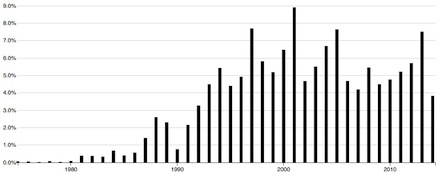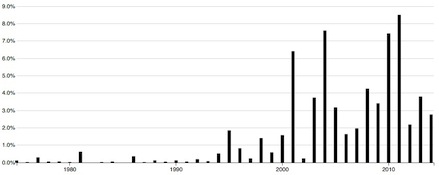Editorial Commentaries Feminist scholars reflect
Former, current, and future editors of Signs, Signs associate editors, and other experts in the field reflect on the changes in the journal's content over time, the changing contexts within which the journal is situated, and the role Signs has played, and continues to play, in shaping women's, gender, and feminist studies.
A Peak in Darien?
Catharine R. Stimpson
In 1817, the English poet John Keats published a famous sonnet about reading the classical Greek poet Homer in a new translation. Excited, exultant, he compares himself to an astronomer seeing a new planet and then to Spanish explorers staring at the Pacific for the first time and looking at each other "with a wild surmise— / Silent, upon a peak in Darien."
To introduce my comment by citing "On first looking into Chapman's Homer" may seem goofily retrograde or simply goofy. However, I have two reasons for doing so. The first is to recover an exuberant language of discovery; the second is to uncover the difficulties of discovery. The speaker of Keats' poem is buoyed by bold intellectual and artistic adventures, but the Spanish soldiers on a mountain in a province of Panama have embarked on conquest and colonization.
To take each reason in turn:
The maps of feminist scholarship that technology can create are electrifying. During my career in feminist scholarship I have dwelt with a technological revolution that has upended my sense of possibilities, be they personal, cultural, socioeconomic, or political. When we started Signs forty years ago in one room at Barnard College, we had two Selectric typewriters, one landline phone, access to a copy machine, and pencils for correcting galleys. Now Signs and its history are on our screens. It is wild fun, as well as instructive, to wander in this domain and wonder at its evolution. Mary Hawkesworth deserves the profound gratitude of all scholars for her brilliant, pioneering editorship.
Over the decades, I had developed my own four-stage map for the study of women and gender, applicable to the United States and elsewhere. I have argued that it begins with the exploration of the destructive differences between women and men; then shows the constructive differences between women and men, the accomplishments of women despite the invidiousness of patriarchy; then analyzes the differences among women; and, finally, situates women and men within gender structures, be they local or global. I have also suggested that of all the words in the English language the prefix "trans" has become the most crucial for our efforts, replacing "inter" as the linguistic connective tissue of ideas and entities. We now speak of transnational more often than international. "Trans" can indicate a transfer of knowledge, transdisciplinarity, translation, transversal of boundaries, transgender, or transcendence. I could demonstrate—although not irrefutably—that my fourfold map was at best reliable, at worst suggestive. It was not a music box tinkling out a loony tune.
However, the maps of scholarship in the virtual Signs are at once far more comprehensive than mine, far more accessible, testable, and, if necessary, changeable. They can be a template for other journals and publications to use in order to understand their own efforts, compare them to Signs, and help reveal the deep compositions of our field. Some of the maps confirm in broad strokes and in detail what many people may have thought or intuited. Yes, the interest in power, sex and sexuality, feminism, and feminist theory has been consistent over the decades. To be sure, "sex workers" as a category grows after 2010, but research and commentary about "prostitution" begins in 1976. Yes, the study of race grows after 1980. Before and after the publication of Kimberlé Williams Crenshaw's historic work in 1989, writers are pursuing the connections and conflicts among race and other markers of identity we name "intersectionalities." Yes, the study of men, masculinity, and gender supplements the study of women. Yes, the study of globalization, and countries other than the United States, surges after the late 1970s and does not recede.
Other maps reveal the dynamic interactions between emerging social and cultural movements and scholarship. No straight, iron track leads from the former to the latter. Instead, they flow together—as rivers do when they meet. Revealing such confluences are articles on Islam, food, and the environment. After 2010, work on the "prison state" increases. Perhaps oddly, after 1990, a once compelling subject—mothers and children—seems to lose some of its magnetism. If this is true, it may be because the first generation of feminist scholars was maturing. The tensions with their own mothers, as well as the rebellions against the fathers, are dwindling.
One difficulty of my discoveries is learning how to measure the degree of power that US institutions exert, the norms they articulate, and the degree of legitimacy they grant. From its very inception, Signs has had advisers, authors, and editors from around the globe. Yet, how "American" does it remain? I need help in grappling with this question and in doffing the blinders of my patriotism. Another difficulty, easier to grasp, if painful, is recognizing the condition of the humanities. They are not silent and invisible amidst the spikes, peaks, and valleys of charts, graphs, and clusters of topics the virtual Signs brings us. Instead, they lack magnitude of presence. Similarly, anthropology as a field seems to have withered.
The editors have curated seventy topics into ten tables of contents that outline pervasively influential concepts or frameworks of thought. One, "Bodies, Identities, Differences," is a bit of a jumble. Another, "Science Studies," shows the interdisciplinary efforts to grasp scientific inquiries and to probe them with the tools that history, rhetorical analysis, sociology, and other disciplines provide. (Significantly, but not surprisingly, the "really" technical work in science and the mathematically based social sciences appears in the disciplinary journals of these fields.) The rest of the tables bring together work in two great categories: the social and political ("Violence and Conflict,""Labor and Political Economy," "Political and Social Movements," "Intersectionalities") and the nature of our field itself ("Methodologies,""Field Formation," "Interventions in Theory"). To oversimplify, the former is our subject, the latter our process. Both, at their best, tell us why they matter, or, in other words, illuminate without braggadocio and bluster, their own significance.
Only one of the ten, fashionably named "Cultural Production," seems humanistic, and it includes the arts, advertising, and the theory and practice of performativity. Film as a genre becomes more muscular; so do "story" and "narrative," equally fashionable rubrics for organized linguistic phenomena across the disciplines and the professions. But poetry as a genre recedes, and heroines of the humanities gently slide from the grace of our interrogations: the French feminist theoreticians and, to my woe, Virginia Woolf.
I would swear on my stack of Signs, kept since the first issue in 1975 with its austere black cover, that no editor is or has been antihumanities. Rather, the material editors solicit, receive, review, select, and manage reflects both the insecurity of the contemporary academic humanities and the outsize role of the humanities in the first decade of women's studies. Many of us came out of the humanities or humanistic social sciences. They were more welcoming to female graduate students and faculty. Moreover, the boundaries between scholars in women's studies and writers outside of the academy participating in women's studies were porous. I scanned the Index to Volumes 1-10, 1975-1985, compiled under the editorship of Jean Fox O'Barr at Duke. Symbolically, among the names of authors are Hélène Cixous, a writer; Elizabeth Hardwick, a writer; Elizabeth Janeway, a writer; Ethel Spector Person, a psychoanalyst and writer; B. Ruby Rich, a film critic who became an academic comparatively late in her career; Adrienne Rich, a writer; and Alix Kates Shulman, a writer.
After one revels in the maps given to us by the virtual Signs, these new continents and oceans of knowledge, one must plunge into them, click on the links to actual articles, and read. Do the articles consistently demonstrate originality, rigor, intellectual power, all those causes of the ongoing significance of the study of women and gender? They do. How fortunate I am to have been sentient during these decades.
Catharine R. Stimpson is University Professor and Professor of English at New York University and was formerly Dean of the Graduate School of Arts and Sciences. She is the Founding Editor of Signs: Journal of Women in Culture and Society and served as editor from 1975 to 1980.
A Comment on Signs' Fortieth Anniversary
Jean Fox O'Barr
Opening a preview copy of Signs 40th anniversary site was like stepping into a time machine.
When the editorial offices moved to Duke and UNC in 1985, neither records nor correspondence were done electronically. Setting up a database of authors, creating a system for acknowledging manuscripts (as well as books for review!) and tracking their progress, communicating by email with reviewers, and eventually editing online were huge challenges.
Somewhere in the midst of this multitasking it occurred to us that we had no way of knowing what had been published by Signs during the first decade. How were we to know "what next" if we had to rely on our individual memories to recall what had been? An index seemed the answer. With the assistance of the University of Chicago office and the energy of several students, we set about creating and publishing a ten-year, hard-copy index. It was sent to subscribers at no cost. Readers, researchers, students, and those of us in the office hailed the advance.
When I place that slender volume next to my computer screen as I browse the virtual issue, I am stunned! For feminists, knowing is the first step in any endeavor. I can only imagine the possibilities that this new inventory opens up! Kudos to the editors and the press for giving us a remarkable new way to propel knowledge forward.
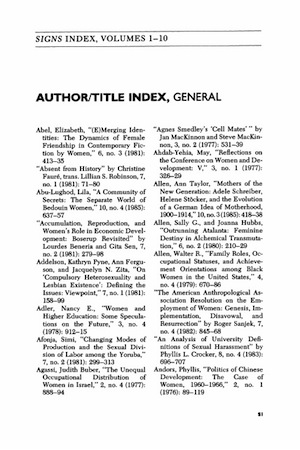
Jean Fox O'Barr is the founder and former director of the Women's Studies Program at Duke University. She served as Editor of Signs from 1985 to 1990.
History in Signs
Kathryn Norberg
What can the fortieth anniversary website tell us about history in Signs? That is the question put to me by Editor Mary Hawkesworth. In this brief comment, I'd like to use the site to determine how much history figures in the Signs corpus and how that history has changed over time. I hope to determine what it tells us about history in Signs, but also what it tells about the history of Signs: that is, the changes in content and emphasis that have occurred in the journal since its inception. My comment sticks close to the site, offering an example of how it can be used and what issues arise when exploring it.
Topic modeling begins with words, and history is a particularly difficult word because it has many definitions. For some people, history is a text written by a professional historian employed by an accredited history department. I think the Signs reader would be unhappy with that definition. Signs is, after all, an interdisciplinary journal. For other people, history means History with the capital H: that is, the past organized around grand ideas ("progress") or theories (Marxism) that claim to explain and rationalize everything. Or it can mean case history or oral history or medical history. Because just about any subject has a historical dimension, the word history can appear in just about any context, usually as a synonym for "the past."
Because of these multiple meanings, I began my exploration of the site by looking at the list of words that emerged from the 1,867 articles published between 1975 and 2014 in Signs. First, I looked for words that historians might use more than other scholars. I immediately found a topic that groups together many such terms, including history, historical, historians, past, and period. History is the first word—that is, the most frequently used word—in the topic, which also includes histories, century, modern, and year, making it seem the most "historical" of all the topics. History also appears among the key words in several other topics, including the topics labeled Bodies, Women's Studies, Black Feminism, and War / Germany, in descending order of importance. In the latter two topics, history stands so far back in the line of words that it appears to have little significance.
The topic composed of historical terms is very significant. It provides 4.1 percent of the Signs corpus—that is, 4.1 percent of all the words in Signs from 1975 to 2014. Four percent may seem very small, but when topics are ranked by their weight in the Signs corpus, this topic comes in fourth place. The anniversary site demonstrates that history has been an important part of the Signs from the beginning.
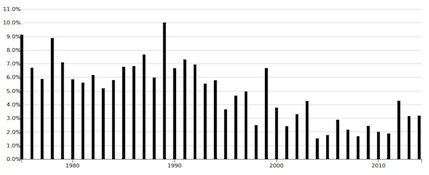
But that importance has varied over time. One of the most interesting features of the anniversary site is the chronological bar graphs located on the left-hand side of the list of topics. These graphs indicate the weight of the topic in each annual volume of Signs. So if we look at the bar graph for Historical Terms, we find that in the 1970s and 80s, history and the other words associated with this topic sometimes contributed 10 percent of the words in the volume for that year. After 1999, the weight of history falls to 2 or 3 percent annually. Whether this decline is significant or random is not indicated on the site, but it is certainly not the only change in the composition of the journal. A topic of quantitative terms (percent, table, number, rate, sample) was the subject of a significant number of articles in the 1970s and 1980s, but it disappears in the 1990s. The topic that includes the terms psychology and psychologists was important in the first years of the journal but vanishes in the 1990s. Other topics grew in importance: the topic grouping the words political, cultural, difference, discourse, discursive, Foucault barely existed in the years before 1985 but ballooned thereafter to contribute almost 10 percent of the words in each volume. Similarly, the topic labeled Globalization (world, global, international, transnational) only appeared around 1995 but now provides as much as 10 percent of the words in several issues.
The great contribution of the anniversary site is to make these changes visible. As far as the discipline of history is concerned, some of this decline is probably caused by competition: that is, the appearance of journals devoted explicitly to feminist history. Feminist Studies (established 1972), long edited by historian Claire Moses, has always published history and organized special issues and forums around historical issues. In the 1990s, two new journals, Gender and History (established 1989) and The Journal of Women's History (established 1990) began publishing solely feminist history. Feminist historians are lucky to have so many excellent outlets for their work, but Signs may have lost some articles to these specialized journals.
In any event, we should not exaggerate the decline of history in Signs. The decrease after 1990 is slight by comparison to the disappearance of psychology or the waning of psychoanalytically informed French feminist theory (Kristeva, Irigaray, Lacan, Cixous, difference, psychoanalysis). The decline is actually illusory. Not all articles containing historical data and methods appear under the Historical Terms topic. There are other topics that include a historical dimension but in which the word history and its synonyms appear rarely or not at all. Take for example the topic tht groups together the words America, suffrage, American, club, house, papers, Boston, sisters, united. It comes as no surprise that most of the articles in this topic deal with nineteenth-century women's struggle to claim political rights, a classic historical project that preoccupied Signs editors and authors during the first twenty years of the journal.
Therefore, it is possible that history continued to be a major element in Signs, but in new forms and therefore under different topics. What appears to be a quantitative change (less history in Signs) is actually a qualitative change (a different history in Signs). For example, the topic on memory, trauma, sexual, survivor deals with history. It includes mainly articles from a special issue on Gender and Cultural Memory edited by Marianne Hirsch and Valerie Smith (2002). The articles in this issue are very different from the articles that fall under the Historical Terms topic. Many analyze fiction, and they often deal with private memory, not the public, collective memory or commemoration studied by historians. Still, the past and its consequences are the subject. Here is a new kind of history, practiced more by literary scholars than historians, but it is nonetheless history.
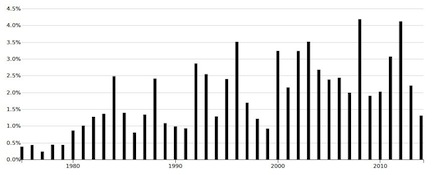
Similarly, the topic labeled Feminist Movements (feminist, feminism, movements, women, movement) deals with history even if the word does not appear in the topic word list. Charting the history of feminism is certainly one of the subjects we expect to learn about in Signs. Feminist Movements contains, for example, a number of articles that engage in the ongoing debate about the metaphor of waves and the degree to which it accurately represents the history of feminism. Disputing previous interpretations, contextualizing the past, and debating conflicting chronologies—what could be more historical?
The topics model indicates not that feminist history is disappearing from Signs but rather that it is changing. Many Signs articles contain references to the past, and yet these articles deal principally with feminist theory, science, prostitution, migration, globalization, and so forth. At the same time, feminist historians have turned away from the history of the early American women's movement to new topics like suffrage in an international context or the history of women outside of the United States and Western Europe. Some old themes continue. Signs may publish fewer articles on the Middle Ages, but it continues to offer articles about women in Renaissance Italy. As in the past, these articles are inspired by contemporary feminist concerns. In the 1970s and 80s, women's liberation drew historians to the suffrage struggle. Today mass incarceration inspires feminist scholars to focus on experiences of women in prison in times and places as different as fourteenth-century Venice and Jim Crow Georgia (see the special issue on Women, Gender, and Prison [Hawkesworth 2013]).
Some of the changes I have pointed out stem not from Signs editorial policies or academic feminism but from the discipline of history itself. The move toward a global history is apparent in the pages of Signs and also in the contents of history journals. For a discussion of how and when this shift from "center" to "periphery" occurred, no better article exists than Bonnie Smith's "Women's History: A Retrospective from the United States" (2010). That Signs continues to publish articles like Smith's aimed specifically at historians and addressing their particular debates testifies to the continuing commitment of Signs editors to feminist history.
So too does the fortieth anniversary website, as I hope I have shown. I have used only a portion of the metrics and visuals offered by the site, but I can still testify that topic modeling made exploring the Signs archive easier and much quicker than it would have been otherwise. Still, there are issues. Some of the topics seem arbitrary, and the articles assembled by a "family of words" seem themselves unrelated, as in this topic. I'm sure that the topic modeling will undergo further refinement in the future, but in the meantime, readers of Signs have at their disposal a powerful new instrument for detecting change in the journal and therefore in academic feminism.
Kathryn Norberg is Associate Professor in the Departments of History and Gender Studies at the University of California Los Angeles (UCLA). From 2000 to 2005 she served as Coeditor, with Sandra Harding, of Signs.
References
Hawkesworth, Mary, ed. 2013. "Women, Gender, and Prison: National and Global Perspectives." Special issue of Signs: Journal of Women in Culture and Society 39, no. 1.
Hirsch, Marianne, and Valerie Smith, eds. 2002. "Gender and Cultural Memory." Special issue of Signs 28, no. 1.
Smith, Bonnie. 2010. "Women's History: A Retrospective from the United States." Signs 35(3):723-47.
Tracking Changes in Transformative Scholarship
Mary Hawkesworth
When academic journals were launched in the 1870s, field formation was part of their objective—clearly delineating science from natural philosophy, humanities from philology, history from philosophy, sociology from history, political science from sociology. But field formation was inseparable from intellectual legitimation, from the generation of scholarly discourses of sufficient erudition to persuade new secular modes of higher education that these recently conceptualized subjects were worthy of serious pursuit within the academic curriculum. When Signs was launched a century later, the "new scholarship about women" faced a similar legitimation challenge but within a markedly wider terrain (Stimpson et al. 1975, v). Rather than carving out a narrow swath, this bold intellectual venture proclaimed itself interdisciplinary and set out to demonstrate that sustained investigation of women's lives would transform the known world, particularly as it was being taught in the humanities, social sciences, and natural sciences in Western universities.
With four decades of continuous publication and some two hundred thousand pages of text to its credit, Signs is well positioned for a reckoning. But how exactly does one evaluate such a sizable academic corpus? For the past eighteen months, the Signs staff has pondered that question, exploring social science and digital humanities analytical techniques to probe the contents of the journal. Under the impressive leadership of Signs Deputy Editor Andrew Mazzaschi, graduate research assistants Susana María Galán Julve and Lindsey Whitmore worked with Professor Dana Britton using NVIVO and Professor Andrew Goldstone using topic modeling to investigate the Signs archive as constructed in JSTOR's Data for Research. The result of this arduous labor is Signs@40, which provides various interactive means to review the emergence and development of key concepts over four decades, examine annual and cumulative bibliographies of critical essays that have contributed to the interdisciplinary field of feminist studies, and ponder cocitational network analysis that traces over time the scholars cited together most frequently in the journal. In addition to these computer-generated resources, the virtual issue includes humanly curated tables of contents for ten topics central to feminist studies.
The topic model is an extraordinary bibliographical resource, but exactly what the topics tell us about the content of Signs is an open question—a question that these "Comments" are designed to press. The topics do not identify the most important articles published in the journal, the most pathbreaking concepts, or the most widely read essays. Instead, the topic model measure sets of words that appear together in a large number of articles, tracing the frequencies of their appearance as a proportion of the scholarly corpus over time, and indicating the precise number of times this set of words appears in each article included in the bibliography for the topic model. As with any hermeneutic project, interpreting the meaning of these sets of words for Signs or for feminist scholarship more generally requires careful study of the articles that contribute to the discourses foregrounded in the topic model, a study necessarily informed by the researcher's knowledge of the field, intellectual interests, theoretical framework, narrative strategy, and ingenuity. As an intellectual resource that enables re-vision, a kind of seeing again that allows us to revisit the past and present in order to know them differently (Plate 2008), we hope that many feminist activists, students, and scholars will use Signs@40.
Mapping transformations
We often characterize feminist scholarship as transformative. And indeed, the scope of the desired transformation is breathtaking in its ambition—for feminists seek to transform manifold dimensions of the world—from individual consciousness and interpersonal relations to social institutions (families, schools, universities, religions, nations, traditions), political organizations (local, municipal, state, regional, national, international), regimes of power that structure daily life (racism, sexism, heteronormativity, ableism, ethnocentrism, ethnic chauvinism, imperialism), as well as academic disciplines and interdisciplines. For my own preliminary excursus into the mysteries of the topic model, I sought to discern transformations in the discourse of feminist scholarship over forty years.
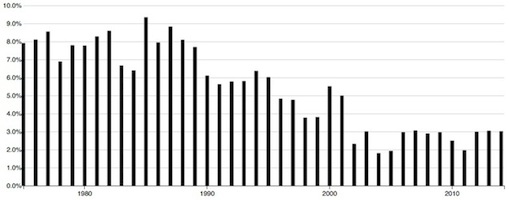
Some of the trends so graphically displayed in the topic model are far from surprising. Most observers would expect that women would be one of the most frequently discussed topics in any endeavor subtitled Journal of Women in Culture and Society. But when a temporal dimension spanning four decades is added, it is quite possible to conclude that the subtitle no longer anchors journal content in the same way that it did in the early years. Women in particular nations, movements, professions, ethnicities, and peoples constituted more than 5 percent of the content of the journal between 1975 and 2000, cresting at 9 percent in 1985. Yet women's proportion of the content has been declining of late, hovering below 3 percent since 2001. If one considers explicit comparisons of women and men, the disappearance of the genre seems all the more pronounced, falling from a high of 9 percent of the content in 1977 to 4 percent in 1990 and—with the exception of 2005, when explicit comparisons of men and women absorbed 3 percent of journal content—has hovered well below 1 percent over the past twenty-five years. Thus, a curious feminist following Cynthia Enloe's (1989) lead might well ask, where are the women, or what has become of women in the journal dedicated to the new scholarship on women?
The twenty-first century has not been kind to mothers, mother-daughter relations, families, or even fatherhood. The topic labeled Motherhood had been losing ground throughout the nineties but entered a period of severe draught in the first fifteen years of the new millennium. Love and romance never reached 2 percent of the content in early decades of the journal but has been seriously on the wane since 2001. What sense can be made of the gradual disappearance of women, mothers, families, and romance from the pages of Signs? Multiple hypotheses suggest themselves: families are out of fashion in this postfeminist age; or the new responsibilization of neoliberal governmentality has succeeded in its project of individuation, with dire consequences for women and families; or, feminist scholars have become as antifamily as the new Right has always alleged.
Additional light can be shed on this question if we consider the topics that have supplanted women. The options are multiple. People, as a gender-inclusive referent appearing in a topic with other common terms, has held steady at 4 percent of the content of the journal across all four decades. In contrast to that constancy, several topics have gained noticeable ground in the past fifteen years. Bodies and desires, although constituting only 1.6 percent of the corpus overall, has roughly doubled in incidence since 2003. Gender, encompassing men, masculinities, femininities, trans, again only 1 percent of the corpus overall, has averaged 2–3 percent of the content in past five years (as evident in the topic labeled Gender Theory). Differences, identities, which comprises 3.6 percent of the corpus overall, has been averaging 4 to 9 percent of the discourse since 2000 (as in the Politics of Difference topic). Similarly, an encompassing discursive strand that spans beauty, femininity, microrebellious bodies, cyberbrides, child porn, love exiles, and feminized patriarchy, which scarcely counted for 0.5 percent of the content prior to 1994, has been gaining momentum, ranging from 2 to 7 percent of the annual content since 1996. Another noticeable shift occurs in the geopolitical purchase of the journal over the past fifteen years. Barely a trace element from the time of the journal's founding, discussions of the world, international, global, transnational erupted in 1995 with heightened attention (2 percent) to the UN Fourth World Conference on Women in Beijing and gained additional momentum in the new millennium, reaching new highs in 2001 (6.5 percent), 2004, and 2009 (7.5 percent) and again in 2011 (8.5 percent) (as shown in the topic labeled Globalization).
Just as many women's studies programs have expanded to incorporate gender studies, sexualities studies, and globalization, the pages of Signs seem to have embraced a conception of feminist studies that is inclusive of a plurality of bodies, modes of embodiment, genders, and geopolitical sites, as well as complex processes of racialized gendering and gendered racialization. Indeed, the topic model suggests that the terms feminist and feminist research have also gained ground in the journal, growing from less than 0.5 percent of the content in the 1970s to more than 3 percent after 2000. The carefully crafted locution, "new scholarship on women," designed to legitimate this intellectual endeavor in the context of an academic universe that was far from feminist friendly, seems to have ably done its work, creating an environment in which feminist scholars dare speak their name.
The bibliographies generated by the topic model illuminates a great deal about changing conceptualizations that accompany the gradual shift from new scholarship on women to feminist studies. Signs created an unparalleled space in which to make new objects the focal point of feminist theorizing. Although feminist theory (narrowly construed) occupies only 1.8 percent of the content of the journal, it has revolutionized understandings of many dimensions of life that cut across traditional academic disciplines. Consider for example, Carroll Smith-Rosenberg's (1975) classic analysis of the female world of love and ritual in the nineteenth century, which challenged historians' notions of subjects worthy of inquiry, evidence, and historiographical method. Encroaching upon philosophical assumptions about intellectual merit, Dorothy Kaufmann McCall (1979) turned to Simone de Beauvoir's Second Sex to demonstrate how attention to women's lives could correct philosophical claims based solely on elite Western male experience. Thus Beauvoir understood, as Jean-Paul Sartre had not, that constraints on freedom exist. Far from being a matter of bad faith, they are the product of situational obstacles tied to race and gender. Moreover, failure to recognize such hindrances only replicate sexist and racist stereotypes, as Sartre's unfortunate allusion to the feminine "In Itself" as "holes and slime" so aptly demonstrates (Sartre 1956, 608). Interrogating the benign constructions of romantic love that mask manifold dimensions of oppression, Adrienne Rich (1980) diagnosed "compulsory heterosexuality" and theorized the lesbian continuum. Julia Kristeva (1981) offered a radical reinterpretation of "women's time" that illuminated gendered aspects of temporality. Jettisoning liberal democratic notions of a neutral, if not benign state, Catharine MacKinnon (1983) theorized the state and its most powerful product, the law, as inherently male, noting that the state "coercively and authoritatively constitutes the social order in the interests of men … through legitimating norms, forms, relations to society, and substantive policies" (644). Indeed, as a site that institutionalizes male norms, perceptions, and desires as the "natural" order of things, the state, MacKinnon argued, has not been and never will be a site for liberation.
An examination of topic models that address substantive issues such as health, labor (in general and in rural economies), violence, or the social suggest, however, that a narrow frame for feminist theory, which restricts it to traditional fields such as philosophy, political theory, jurisprudence, or the history of ideas does not do justice to the innovative modes of theorizing that have become a hallmark of Signs. As an integral component of feminist analysis, feminist theory permeates the content of the journal, contesting established terms of debate, recasting traditional concepts, introducing new analytical frames, constructing new objects of inquiry, and charting new directions for research. Consider, for example, how 1970s discussions of pregnancy, abortion, contraceptives for men, and sexual control were superceded in the 1980s by a powerful global vision of and demand for reproductive freedom (Petchesky 1980). A decade later infertility surfaced in pages of Signs, followed in the twenty-first century by critical discussions of menstrual suppression, genetic counseling, commercial surrogacy, and other forms of reproductive and genetic technologies.
Feminist theorizing of labor/work (e.g., in the Labor and Rural Economies topics) not only made women's unwaged work visible but illuminated the explanatory potential of sex segregation in the labor force as a means of creating and perpetuating gender inequality. Signs authors conceptualized domestic labor as an arduous form of unwaged and racialized work. They documented the high incidence of women-headed households, debunking the myth of the male breadwinner. Scholars publishing in Signs also developed innovative analyses of gender and development, service work as a racialized category, women in state socialism, the transnational care economy, the negative consequences of microfinance, and carceral capitalism.
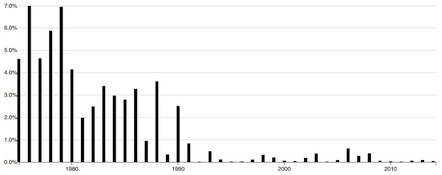
Operating as a negative heuristic, feminist theorizing in the journal also cautioned against unfruitful ways of investigating gender inequality, most notably in relation to psychology and sex differences, which crested in 1976 and suffered a gradual decline through 1990, by which time it had been repudiated as "mismeasuring women" (Kramer and Lehman 1990). Similarly, simplistic notions of biological sex or, indeed, sociobiology (a subset of the Biology of Sex topic) have not fared well in Signs over time. Early discussions that treated biology as untroubled ground gave way to sophisticated feminist science studies that show how raced-sexed-gendered concepts are produced in and through science and naturalized, whether those concepts involve bodies and behavior (Longino and Doell 1983), eggs and sperm (Martin 1991), sexual dimorphism and racial difference (Markowitz 2001), sex genes (Fujimura 2006), or X as the "female chromosome" (Richardson 2012). In contrast to reductionist accounts of biology that continue to populate mainstream media, Signs authors demonstrated how theorizing intersex and transgender illuminate the nexus of embodiment, gender, and oppression (Kessler 1990; Rubin 2012; Bettcher 2014) and how lessons from feminist scholarship could transform fields such as evolutionary biology (Gowaty 2003), physics, and cosmology (Barad 2003).
Over the past four decades, one might argue that feminist theorizations of violence have jumped scale. Like feminist activism in the 1970s and 1980s, feminist scholarship in Signs sought to document the prevalence of rape, dispel the myth of stranger rape, and conceptualize a feminist response to crimes against women (Albin 1977; Pleck 1983; Russell and Howell 1983). Shattering the silence surrounding domestic violence, feminist scholars conceptualized marital rape, intimate violence, family violence, and childhood sexual abuse (Breines and Gordon 1983; Frieze 1983; Gee 1983). In the twenty-first century, however, feminist scholars turned their analytic lenses to gendered violence on a global scale, theorizing "the logic of masculinist protection" that feminizes whole citizenries in a homeland security state (Young 2003), rape as an instrument in war (Bos 2006), the raced-gendered logics and effects of war (Hawkesworth and Alexander 2007a, 2007b), the complex interconnections between ordinary (peacetime) and extraordinary (wartime) violence (George 2007), and necropolitics in the context of femicide and genocide (Wright 2011; Gobodo-Madikizela, Fish, and Shefer 2014).
Perhaps no topic is more rife with interpretive possibilities than that labeled The Social, which enigmatically links the terms social, power, and experience. Like the feminist slogan of the 1970s, "the personal is political," the discursive strands of this model call attention to the social constitution of experience while noting that power pervades even the most benign facets of the social and the personal. This topic has maintained an impressive presence across all four decades. At the time of the journal's launch, this topic occupied 11 percent of the journal's corpus, more than twice the incidence of any other topic. It increased it proportion of content to 14 percent by 1982 and preserved that average until cresting at 20 percent in 2005. And its share of journal content has remained well above 16 percent for most years over the past decade.
What exactly are we to make of a discourse so capacious that its "top documents" alone roam from early discussions of empowerment and pathbreaking work on intersectionality to a recent analysis of "intimate justice and the dark ghetto" (Threadcraft 2014)? Examining the changing content of this discursive category over forty years provides its own microintroduction to the interdisciplinary field of feminist scholarship. The social takes markedly different forms as the new research on women develops over time: social life, social roles and responsibilities, social networks, and the surge in women's work in the 1970s, suggesting the sure footing of a social science–inflected liberal feminist research agenda. The 1980s took a radical turn as Adrienne Rich's brilliant analysis of "Compulsory Heterosexuality" (1980) illuminated aspects of social relations that muddied neat distinctions between coercion and consent. Terms of analysis typically associated with socialist feminism gained ground in the early eighties as Signs articles explored class relations, social reproduction, and collective action. The searing critique lodged by Maxine Baca Zinn, Lynn Weber Cannon, Elizabeth Higginbotham, and Bonnie Thornton Dill (1986), "The Costs of Exclusionary Practices in Women's Studies," raised powerful and enduring questions about the boundaries of sociability within the intellectual field while also opening a space for discussions of social knowledge, social privilege, lesbian separatism, and "feeling foreign in feminism" (Lâm 1994). To make sense of the pervasive fragmentation and disunity among women despite certain aspects of shared oppression, Iris Marion Young (1994) appropriated Sartre's conception of seriality to theorize gender, envisioning the social in relation to structural forces that position members of one sex as if they shared attributes in common. But this passive bond imposed by situational determinants was insufficient, Young argued, to generate transformative action—something that could be achieved only through explicit mobilization of women as a political group.
As the 1990s progressed, the social took a global turn as Signs authors began world travelling, exploring languages, Islam, geopolitics, Western eyes, epistemological chasms, and femicide (Mohanty 2003; Shalhoub-Kevorkian 2003). In the early twenty-first century, the social surfaced in a feminist politics of recognition that coexisted with feminist critiques of homeland securitization policies and "developmental democracy" (Keating 2004). The social was manifest in exclusionary inclusions and misrecognitions that permeated both the politics of presence for elite women and global sweatshops for the dispossessed.
"Discordant Connections," as conceptualized by 2009 Stimpson Prize winner Seema Arora-Jonsson, characterizes far more than alternative understandings of gender inequality and possibilities for its redress in forest communities in India and Sweden. It also provides an apt metaphor for forms of sociality found in queer feminist bathhouses in Toronto (Cooper 2009), legislation pertaining to nonconjugal relations in Alberta and Hawaii (Harder 2009), and poignant reinterpretations of the punitive effects of historic heteroessentialism (Manion 2009).
The sites of the social that appear in the pages of Signs have continued to proliferate over the past decade as comparative perspective symposia focused on democratization, Islamization, refugee camps, indigenous feminisms, Romani feminisms, medical tourism, and major articles took up transgressive intimacy, postsocialism, sexual barter in a time of genocide, necropolitics and prison rape, intersectional resistance, and unfinished revolution. That one topic can provide such a whirlwind tour of feminist scholarship is a testament to the scholarly potential of this model once plumbed. That the pages of Signs continue to illuminate so many facets—positive and negative—of the complex nexus of the social, power, and experience makes clear how critical feminist scholarship is to the revolution in thought that is prolegomena to social transformation.
Mary Hawkesworth is Distinguished Professor of Political Science and Women's and Gender Studies at Rutgers University. From 2005–2014, she served as Editor of Signs: Journal of Women in Culture and Society.
References
Albin, Rochelle Semmel. 1977. "Psychological Studies of Rape." Signs: Journal of Women in Culture and Society 3(2):423–35.
Arora-Jonsson, Seema. 2009. "Discordant Connections: Discourses on Gender and Grassroots Activism in Two Forest Communities in India and Sweden." Signs 35(1):213–40.
Barad, Karen. 2003. "Posthumanist Performativity: Toward an Understanding of How Matter Comes to Matter." Signs 28(3):801–31.
Bettcher, Talia Mae. 2014. "Trapped in the Wrong Theory: Rethinking Trans Oppression and Resistance." Signs 39(2):383–406.
Bos, Pascal. 2006. "Feminists Interpreting the Politics of Wartime Rape: Berlin, 1945; Yugoslavia, 1992–1993." Signs 31(4):995–1025.
Breines, Wini, and Linda Gordon. 1983. "The New Scholarship on Family Violence." Signs 8(3):490–531.
Cooper, Davina. "Caring for Sex and the Power of Attentive Action: Governance, Drama, and Conflict in Building a Queer Feminist Bathhouse." Signs 35(1):105–30.
Enloe, Cynthia. 1989. Bananas, Beaches, and Bases: Making Feminist Sense of International Politics. New York: HarperCollins.
Frieze, Irene Hanson. 1983. "Investigating the Causes and Consequences of Marital Rape." Signs 8(3):532–53.
Fujimura, Joan H. 2006. "Sex Genes: A Critical Sociomaterial Approach to the Politics and Molecular Genetics of Sex Determination." Sign 32(1):49–82.
Gee, Pauline W. 1983. "Ensuring Police Protection for Battered Women: The Scott v. Hart Suit." Signs 8(3):554–67.
George, Rosemary Marangoly. 2007. "(Extra)ordinary Violence: National Literatures, Diasporic Aesthetics, and the Politics of Gender in South Asian Partition Fiction." Signs 33(1):135–58.
Gobodo-Madikizela, Pumla, Jennifer Fish, and Tamara Shefer. 2014. "Gendered Violence: Continuities and Transformation in the Aftermath of Conflict in Africa." Signs 40(1):81–99.
Gowaty, Patricia Adair. 2003. "Sexual Natures: How Feminism Changed Evolutionary Biology." Signs 28(3):901–21.
Harder, Lois. 2009. "The State and the Friendships of the Nation: The Case of Nonconjugal Relationships in the United States and Canada." Signs 34(3):633–58.
Hawkesworth, Mary, and Karen Alexander, eds. 2007a. "War and Terror I: Raced-Gendered Logics and Effects in Conflict Zones." Special issues of Signs 32, no. 4.
———, eds. 2007b. "War and Terror II: Raced-Gendered Logics and Effects beyond Conflict Zones." Special issues of Signs 33, no. 1.
Keating, Christine. 2004. "Developmental Democracy and Its Inclusions: Globalization and the Transformation of Participation." Signs 29(2):417–37.
Kessler, Suzanne J. 1990. "The Medical Construction of Gender: Case Management of Intersexed Infants." Signs 16(1):3–26.
Kramer, Pamela E., and Sheila Lehman. 1990. "Mismeasuring Women: A Critique of Research on Computer Ability and Avoidance." Signs 16(1):158–72.
Kristeva, Julia. 1981. "Women's Time." Signs 7(1):13–35.
Lâm, Maivân Clech. 1994. "Feeling Foreign in Feminism." Signs 19(4):865–93.
Longino, Helen, and Ruth Doell. 1983. "Body, Bias, and Behavior: A Comparative Analysis of Reasoning in Two Areas of Biological Science." Signs 9(2):206–27.
MacKinnon, Catharine A. 1982. "Feminism, Marxism, Method, and the State: Toward Feminist Jurisprudence." Signs 8(8):635–58.
Manion, Jennifer. 2009. "Historic Heteroessentialism and Other Orderings in Early America." Signs 34(4):981–1003.
Markowitz, Sally. 2001. "Pelvic Politics: Sexual Dimorphism and Racial Difference." Signs 26(2):389–414.
Martin, Emily. 1991. "The Egg and the Sperm: How Science Has Constructed a Romance Based on Stereotypical Male-Female Roles." Sign 16(3):485–501.
McCall, Dorothy Kaufmann. 1979. "Simone de Beauvoir, The Second Sex, and Jean Paul Sartre." Signs 5(2):209–23.
Mohanty, Chandra Talpade. 2003. "'Under Western Eyes' Revisited: Feminist Solidarity through Anticapitalist Struggles." Signs 28(2):499–535.
Petchesky, Rosalind Pollack. 1980. "Reproductive Freedom: Beyond 'A Woman's Right to Choose.'" Signs 5(4):661–85.
Plate, Liedeke. 2008. "Remembering the Future, or, Whatever Happened to Re-Vision." Signs 33(2):389-411.
Pleck, Elizabeth. 1983. "Feminist Responses to 'Crimes against Women,' 1868-1896." Signs 8(3):451–470.
Rich, Adrienne. 1980. "Compulsory Heterosexuality and Lesbian Existence." Signs 5(4):631–60.
Richardson, Sarah S. 2012. "Sexing the X: How the X Became the 'Female Chromosome.'" Signs 37(4):909–33.
Rubin, David A. 2012. "'An Unnamed Blank That Craved a Name': A Genealogy of Intersex as Gender." Signs 37(4):883–908.
Russell, Diana E. H., and Nancy Howell. 1983. "The Prevalence of Rape in the United States Revisited." Signs 8(4):688–95.
Sartre, Jean-Paul. 1956. Being and Nothingness. Translated by Hazel Barnes. New York: Philosophical Library.
Shalhoub-Kevorkian, Nadera. 2003. "Reexamining Femicide: Breaking the Silence and Crossing 'Scientific' Borders." Signs 28(2):581–608.
Smith-Rosenberg, Carroll. 1975. "The Female World of Love and Ritual: Relations between Women in Nineteenth-Century America." Signs 1(1):1–29.
Stimpson, Catharine, Joan N. Burstyn, Domna C. Stanton, and Sandra M. Whisler. 1975. "Editorial." Signs 1(1):v–viii.
Threadcraft, Shatema. 2014. "Intimate Justice, Political Obligation, and the Dark Ghetto." Signs 39(3):735-60.
Wright, Melissa W. 2011. "Necropolitics, Narcopolitics, and Femicide: Gendered Violence on the Mexico-US Border." Signs 36(3):707–31.
Young, Iris Marion. 1994. "Gender as Seriality: Thinking about Women as a Social Collective." Signs 19(3):713–38.
———. 2003. "The Logic of Masculinist Protection: Reflections on the Current Security State." Signs 29(1):1–25.
Zinn, Maxine Baca, Lynn Weber Cannon, Elizabeth Higginbotham, and Bonnie Thornton Dill. 1986. "The Costs of Exclusionary Practices in Women's Studies." Signs 11(2):290–303.
Feminist Theory, Signs, and the Lure of the Digital
Suzanna Danuta Walters
A good academic journal is a wondrous thing. For generations of scholars, scraping together a few dimes enabled us to get subscriptions to the few coveted journals that seemed indispensable to our actual learning as well as our more dubious cultural capital. As a graduate student in the 1980s, I too had my precious subscriptions that marked me as a member of the club I was trying hard to get into. Receiving the new issue of Signs was not only a chance to breathe deeply of the feminist theory that was fast becoming my oxygen but also an opportunity to engage in collective disputation with fellow students and our mentors. It may sound strange to those used to accessing materials through library portals or through scanned pdfs of individual articles, but there was (back in the day) a very physical and tactile encounter with each new issue that stayed with me as, along with everyone else, I have been pulled into our new world of virtual everything.
This is a rather long-winded way of stating the obvious: much has changed. While the death of print remains the clarion call of both apocalyptic nostalgics and celebratory technophiles alike, the truth is: print still remains; even when transposed into nonprint forms it has at the very least left traces of its printishness, if not its Colbertian "truthiness." But the digital has increasingly become all the rage, and solid and established academic journals can ill afford to bury their heads in the sand as the juggernaut of mapping and coding, tracking and tracing bounds past the remnants of older ways. Unlike some other journals (I will not name names: you know who you are) Signs, I am happy to say, has embraced these challenges head on and has done so in a way that is less "drinking the Kool-Aid" and more nibbling at the heterogeneous tapas to discover the tastiest morsels.
This discernment is critical: digital humanities (DH) projects have no doubt become one of the few sites in which substantive funding is available and DH institutes and centers are popping up on campuses around the country. Indeed, many frame DH as the white knight on a horse that will rescue the damsel of "humanities scholarship" who we are (incessantly) told is in some serious distress. I use the gendered and raced language here deliberately, as—surprise, surprise!—DH is largely populated by the usual suspects of academic hierarchies, although a brave few have been making critical inroads into the white masculinity that has been the motor for this machine. Feminists and queers of color have been particularly engaged with examining the lacunae and biases embedded in many DH initiatives and have launched their own projects (e.g., Transform DH, Diaspora Hypertext) that queer DH in multifarious and exciting ways.
So I must admit I approached the very idea of "topic modeling" and the associated grids and schemas with if not outright fear then certainly a modicum of trepidation. Besides the fear of the new, and the lefty reluctance to embrace the trend of the moment, many feminists are, I think, curious about the actual usefulness of this work. We are concerned, for example, that this modeling—the need to quantify and graph everything—reflects a persistent scientism and empiricism that has come roaring back in the wake of the cultural and interpretative turn. What intellectual and political questions can be addressed in new ways through these methods? Are new routings and displays of data informative ipso facto, or can they produce obfuscations that substitute big data for big thinking?
I wish I had even an inkling of an answer to these and other pressing concerns about the digital move, but alas I am stumbling in the dark. However, the project here at Signs offers a chance to approach this hornet's nest without worrying about being stung, for the feminist motivations of this project are unquestioned, and the goal—to attempt greater knowledge of the historical trajectory of a journal and how its practices circulate and cohere around certain themes and not others—is of deep interest to me and I would guess to most Signs readers and authors. Indeed, of late I have been quite concerned with what one might call the politics of citationality. British feminist Clare Hemmings, in her provocative book Why Stories Matter (2011), discusses "citation tactics" that create particular narrative arcs for feminism writ large and surely for academic Western feminist practices and subjectivities more pointedly. Hemmings produces a sort of genealogy or even archaeology of citational practices that don't just reveal our overreliance on certain theorists and concepts but unpack a deeper investment in producing "just so stories" of feminism that come to have the status of inevitable "truth" and thus make it more difficult to tell counternarratives or even to see the stakes embedded in the way we tell stories and cite theorists and theories. As the incoming Editor of this journal, I am anxious to pay increased attention to who gets heard and why, to what gets repetitiously circulated and what seems to be consigned to the nether reaches of intellectual importance, to how the vast and complicated and confusing story of "feminism" gets told. (And how we even define the object "feminism" is up for grabs….)
A few general points emerged immediately for me as I jumped around this virtual space of maps and grids and topics. First, it is impressive! One thing that becomes immediately clear is the topical and interdisciplinary range of the journal. Second, and this is perhaps a bit more difficult, is that it is hard to interpret this material without a broader context. And by context I mean not only a broader social and intellectual context but the context of journal publishing itself. So, for example, while I was intrigued by the dramatic shift in a topic that one could call a grouping of rather social scientific, psychological, and even traditional concepts associated with earlier iterations of feminist analysis, from a height in the first decade or so of Signs to almost invisibility post-1993 or so, I would be hard pressed to simply lay this shift at the foot of "feminist studies" writ large or even editorial decisions being made at the journal. Indeed, to know more about this analytically, we would want to think about what new journals came out that may have pushed that type of scholarship out of Signs and into other (perhaps more disciplinary?) venues. I think here of Gender & Society, founded in 1987, which may indeed have played some role in what appears to be a dramatic drop-off in this strain of social scientific and psychological research in Signs. On the other hand, Psychology of Women Quarterly began about the same year Signs did … so it's hard to understand completely the reasons for this shift in Signs. In other words, this topic modeling provides information on shifts over time—for sure—but how to read those shifts is unclear, given the numerous factors that must come into play.
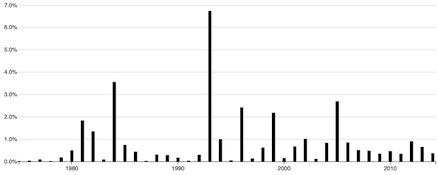
So I want to muse briefly on how this endeavor of topic modeling plays out in one specific arena, an arena in which much of my own work is located: queer and sexuality studies. It appears as if this is a topic that would be "mine" to mine: it includes the words lesbian, gay, queer, homosexuality, sexuality, and many more. These are, to be sure, a few of my favorite things. What also become clear is that this topic is a fairly minor note in the corpus of the journal, coming in at 0.8 percent, although even that seemingly low number is hard to interpret as the majority of the 70 topics have under 1.0 percent representation in the overall corpus. Thus, we might say Signs really does let a thousand flowers bloom, a good thing for both gardens and theories.

Topic exclusion is of course as interesting as inclusion. So, for example, another topic that I would like to claim as "mine"—the topic labeled Feminist Movements, which includes the words feminist, feminist, consciousness, rights, radical, collective, liberation, etc.—does not, curiously, contain the word queer or the word lesbian. And conversely my other topic does not contain either feminist or feminism. One might see this as some evidence of the nagging divides between queer studies and feminist studies, or even between sexuality and gender. It is worth noting, as well, that the Feminist Movements topic is strong and steady throughout the history of the journal, whereas Lesbian, Gay, Queer is a bit spikier and sporadic. Even more worrisome (and this one hurts): the word lesbian is to be found in only one topic, and the same is true for gay and homophobia, although queer pops up a bit more. Surely, this means we have some work to do in making those lavender flowers bloom a bit more promiscuously in Signs. Here, I think the larger context of, say, journal production is less relevant. Newer journals such as GLQ, differences, and Sexualities might be noted if we saw a decrease over time, but they can't account for the absence of these terms as intrinsically connected to other topics of feminist concern. In other words, the isolation of, say, lesbian or queer in one topic area of Signs should prompt us to do some stock-taking specifically (once again, the disappearing lesbian!) and more broadly (how can queer studies and sexuality studies be fully engaged in and with feminist theorizing?). This problem comes up again in the "human" aspect of this endeavor, when the curated tables of contents seems to sideline sexuality and queer studies as well.
The Signs staff and editorial team have offered us all an enticement and a heady mix of longue durée and snapshot that is rich in interpretative possibilities. The digital alchemists have only mapped the field. The point, however, is to analyze it.
Suzanna Danuta Walters is director of Women's, Gender, and Sexuality Studies and professor of Sociology at Northeastern University. She will serve as Editor in Chief of Signs beginning in 2015. Her recent book is The Tolerance Trap: How God, Genes, and Good Intentions are Sabotaging Gay Equality.
Reference
Hemmings, Clare. 2011. Why Stories Matter: The Political Grammar of Feminist Theory. Durham, NC: Duke University Press
Social Sciences in Signs
Dana M. Britton
As a self-professed data geek, I am thrilled at the ability, through topic modeling, to capture the broad scope of the Signs corpus over the journal's forty-year history. The model gives one the ability to see how topics-as operationalized by particular groups of words-have waxed and waned in coverage over the life of the journal. I am a sociologist by training, so I am particularly interested in the coverage of sociology. When I began my PhD program in 1989, the advice I received about Signs was that it was no longer a place to publish mainstream social science - certainly not the kind involving numbers. Among (some) sociologists of gender, I have also heard also a collective sense that in articles published in Signs, concerns about inequality have become more rooted in textual analyses than structural and materialist ones. To put things in simple terms, Signs has the reputation among many sociologists-and social scientists more broadly-of being a journal much more welcoming to the humanities than the social sciences. The topic model provides a way to explore this assumption.
There are two topics that seem particularly relevant for addressing this question so far as coverage of sociology goes: the topic labeled Labor, which includes the words work, labor, workers, working, employment, jobs, economic, andwages, and the topic labeled Quantitative Methods, which includes the words percent, women, men, data, table, number, and rate. In the list view of the model, these topics rank 8 and 10 in their coverage out of the seventy topic groups. The timelines for both topics are shifted to the left, meaning that the peaks for scholarship in this vein appear in the early years of Signs' publication. Other social sciences exhibit this trend as well. Psychology, at least as captured in the Psychology topic, which includes the words sex, research, differences, psychology, behavior, and Anthropology, which includes the words anthropology, human, behavior, societies, cultural, and kinship, also received the most coverage in the earliest years of the journal.

Conversely, there are a number of topics that are highly shifted to the right, which seems to bear out this received wisdom about the decline of the social sciences and the rise of the humanities in Signs. For example, the topic labeled Media Images, which contains the words public, beauty, andimages; the topic labeled Bodies, which contains body, subject, place, desire, and Butler; and the topic that groups the terms cultural, discourse, discourses, and identity all have timelines shifted to the right, meaning they are all much more common in the later years of the journal.
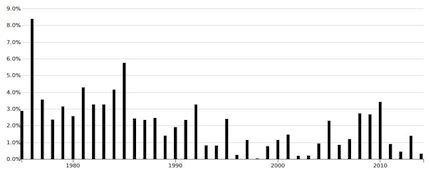
In the earliest years, Signs' coverage of social science was groundbreaking. This was particularly true at a time when feminist scholarship in sociology, economics, psychology, political science, and other disciplines was just beginning to appear, and when there were few disciplinary outlets for its publication. The topic that includes the terms related to work, has its highest peak in the distribution in 1976, when Signs published a special issue titled "Women and the Workplace: The Implications of Occupational Segregation" (Blaxall and Reagan 1976). The issue was a companion to a conference on occupational sex segregation that had been held at Wellesley in 1975 (named International Women's Year by the United Nations) and funded in part by the Committee on the Status of Women in the Economics Profession. The single article that ranks highest in the list for the inclusion of these terms appeared in 1984. In this piece, Joan Smith (1984) linked women's increasing poverty to the rising number of female-headed households and the growth of low-paid, service-sector occupations. These concerns are very much on the policy agenda today. After 1985, there is not another significant peak in the distribution of these terms until 2010, when Signs published a special issue titled "Women in Agriculture" (Sachs and Alston 2010). That issue contains a topic that groups terms that overlap with this one; it also includes the words labor, production, rural, household, and agriculture. The distribution of this topic is shifted to the early years of the journal as well, with the exception of the special issue in 2010.
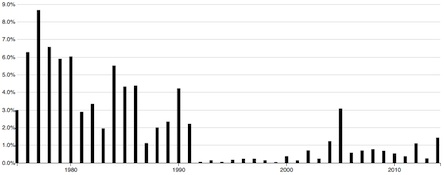
The topic labeled Quantitative Methods, which includes terms related to data (and the term data itself) also peaks in Signs' early years: 1976, 1977, and 1978, in particular. Two of these peaks are related to special sections of issues that aimed to capture the state of the art in the various social sciences. The first, in volume 2, number 1 (1976), is titled "The New Scholarship: Review Essays in the Social Sciences." The second, in volume 3, number 3 (1978), is titled "The New Scholarship about Women: Review Essays." These sections are comprised of review essays that aimed to collect new scholarship about gender emerging across the disciplines. The top-ranking item in this topic (in terms of the percentage of this word group), is Paula England's article, "Women and Occupational Prestige: A Case of Vacuous Sex Equality" (1979). At the time, status attainment models-in which fathers' socioeconomic status was used to predict sons'-still dominated the sociological study of inequality. In this article, England demonstrated that occupational prestige scales, used widely in such studies, had little meaning for understanding the meager material rewards of women workers. This piece, as well as earlier pioneering work by Joan Acker (1973) and others fundamentally challenged a field of study for which women, and women's inequality, had been invisible. However by the early 1990s, this topic group had essentially disappeared from the pages of Signs, though there is one notable peak in 2005 that is mostly accounted for by two articles in which the authors used quantitative methods (Caiazza 2005; Nielson et al. 2005).
So what accounts for the decline in these topics over the forty-year history of the journal? No doubt some of it has to do with the growing legitimacy of gender scholarship within the social science disciplines themselves. Many social sciences now have specialty outlets for work on gender; for example, Gender & Society, which is published by Sociologists for Women in Society, was founded in 1986 and has published extensively on these topics. In more recent years, gender research has begun to appear sporadically in mainstream sociology outlets such as the American Sociological Review and the American Journal of Sociology. For sociological scholars of gender, the pressures of mainstream legitimacy, as well as those created by tenure and promotion practices that are housed within the discipline, have undoubtedly accelerated this move away from interdisciplinary outlets like Signs.
But it may also be that my own assessment is grounded in a far-too-narrow view of what sociological scholarship is. Certainly not all of it is in the positivist mode that requires data, tables, and percentages-though the most valued and legitimated knowledge in my discipline remains so. And though early sociologists of gender began by focusing on material inequalities around work, later generations have brought a gendered lens to culture, bodies, and identities. Signs has been a very hospitable place for that sort of work in recent years, as the topic models indicate.
Still, at least on my reading, the topic model indicates that the conventional wisdom is basically accurate-over the years, Signs has come to focus less on social science and more on the humanities. Whether that is a desirable development is a matter reasonable people might debate; I see it as a loss for feminist social science and for the journal. I would like to believe that my position derives from more than my own positivist disciplinary bias, however. The feminist social scientists who published in the journal in Signs' early years focused on the data documenting gender discrimination because they understood that data provides a kind of public currency, and numbers drive policy. The inequalities women experience are grounded in more than texts. Scholarship that helps us to understand the material conditions of women's lives is crucial if we are to make meaningful change. Signs still has a valuable role to play in highlighting the best of that scholarship.
Dana Britton is Professor and Director of the Center for Women and Work at Rutgers University and is an Associate Editor of Signs. She is the former Editor of Gender & Society.
References
Acker, Joan. 1973. "Women and Social Stratification: A Case of Intellectual Sexism." American Journal of Sociology 78 (4): 936-45.
Blaxall, Martha, and Barbara B. Reagan, eds. 1976."Women in the Workplace: The Implications of Occupational Segregation." Special issue of Signs: Journal of Women in Culture and Society 1, no. 2 (suppl. 2).
Caiazza, Amy. 2005. "Don't Bowl at Night: Gender, Safety, and Civic Participation." Signs 30(2):1607-31.
England, Paula. 1979. "Women and Occupational Prestige: A Case of Vacuous Sex Equality." Signs 5(2):252-65.
Nielsen, Joyce McCarl, Robyn Marschke, Elisabeth Sheff, and Patricia Rankin. 2005."Vital Variables and Gender Equity in Academe: Confessions from a Feminist Empiricist Project." Signs 31(1):1-28.
Sachs, Carolyn, and Margaret Alston, eds. 2010. "Women in Agriculture." Special issue of Signs 35, no. 2.
Smith, Joan. 1984. "The Paradox of Women's Poverty: Wage-Earning Women and Economic Transformation." Signs 10(2):291-310.
Reproductive Cycles
Cynthia R. Daniels
Over the past forty years, Signs' attention to issues of human reproduction has waxed and waned in roughly ten-year cycles. Through each of these, we see the evolution of feminist thinking on questions of human reproduction.
Cycle #1: Parity is not enough, circa 1980
Emblematic of the first cycle was the publication of a Nancy Schrom Dye's review essay,"History of Childbirth in America" (1980), as well as Rosalind Pollack Petchesky's "Reproductive Freedom: Beyond 'A Woman's Right to Choose'" (1980), both of which were part of a special issue on sex and sexuality. Attention to that which is unique to the female sex—parturition— also forms the basis for reflections on Linda Gordon's Woman's Body, Woman's Right (1976), as well as Adrienne Rich's Of Woman Born (1976). These works are theoretically rich, pointing to the insufficiency of "parity with men" and masculine "liberal rights" as bases for gender equality. While primary attention focused on pregnancy, birthing, and maternity, the 1980s also hint at questions of racial and ethnic diversity and issues of coerced reproduction, with a few pieces on global population control, sterilization in Nazi Germany, and Latina and African American women's reproductive health.
Cycle #2: Geographical travels, circa 1990
This cycle marked a shift toward the historical and contextual, with explorations of reproduction traveling across centuries and continental borders of North America, Asia, Europe, and Africa. Articles appear on reproductive politics in Japan, Nigeria, Poland, Italy, and Uganda. This expansion marks a growth of consciousness regarding the complexity of reproductive issues across time and place: reproduction is no longer simply a locale of female power but the source of social and political manipulation and control of women by others. Reproduction is used in the service of imperialism or rapid industrialization; female infertility becomes entwined with issues of national virility. In addition, in the early nineties, critiques, such as Emily Martin's "The Egg and the Sperm" (1991) and Mary Shanley's "Surrogate Mothering" (1993) point to the (potential) ability of the technological sciences to shift the locus of reproductive control away from women.
Cycle #3: Prenatal space, circa 2000
The turn of the century witnessed a move toward "inner space" and reflections on transformative (and potentially oppressive) "occupations of the womb." Prenatal space (Stormer 2000) is configured as a site of technological power struggles over contraception, home birthing, fertility control, pronatalism, antinatalism, fetuses, race, gender, and representations of the female pelvis. Pieces such as Sally Markowitz's "Pelvic Politics" (2001), Laury Oaks's"Smoke-Filled Wombs" (2000), Amy Kaler's article on contraceptive diffusion in Rhodesia (2000), Nilanjana Chatterjee and Nancy Riley's work on fertility control in India (2001), and Susan Greenhalgh's exploration of China's one-child policy (2001) explore the womb as an increasingly contested space.
Cycle #4: The new utopia … or dystopia?, circa 2010
New reproductive technologies take center stage in this cycle, with a particularly outstanding thematic issue (Bumiller, Shanley, and Smith 2009) on reproductive and genetic technologies containing articles such as Lisa Ikemoto's on "eggs as capital" (2009); Silja Samerski's on genetic counseling and the "fiction of choice" (2009); Dorothy Roberts' on race, gender, and the new "reproductive dystopia" (2009); Mary Shanley and Adrienne Asch's on involuntary childlessness (2009); and Laura Mamo and Jennifer Fosket's (2009) on the "(re)making of menstruation." As is the hallmark of Signs, these pieces introduce theoretical subtlety and sophistication to our understanding of new technological reproductive potentials. In particular, Sujatha Jesudason's piece ("In the Hot Tub"; 2009) reminds us of the interwoven issues of social engineering, eugenics, commercialization, and "patriarchal technologizing" (901) embedded in the fertility and childbirth industries. Articles in 2010 and 2011 take on the new forms of kinship made available to women across the globe, sometimes at the expense of other women, such as Amrita Pande's on the "manufacturing of the perfect mother-worker" in Indian surrogacy (2010) or Sven Bergmann's on "fertility tourism" (2011).
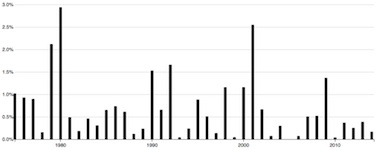
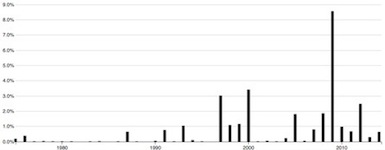
Nearly every leading scholar working in the area of reproductive politics has made an important appearance in Signs over these forty years. It is a tribute to the prescience of the Signs editors that they have fostered a body of scholarship on human reproduction that stands, collectively, as the most important work in this field.
Cynthia R. Daniels is Professor of Political Science at Rutgers University and an Associate Editor of Signs. She also serves as the Associate Campus Dean for Douglas Campus.
References
Bergmann, Sven. 2011. "Fertility Tourism: Circumventive Routes That Enable Access to Reproductive Technologies and Substances." Signs: Journal of Women in Culture and Society 36(2):280-89.
Bumiller, Kristin, Molly Shanley, and Anna Marie Smith, eds. 2009. "Reproductive and Genetic Technologies." A thematic issue of Signs 34, no. 4.
Chatterjee, Nilanjana, and Nancy E. Riley. 2001. "Planning an Indian Modernity: The Gendered Politics of Fertility Control." Signs 26(3):811-45.
Dye, Nancy Schrom. 1980. "History of Childbirth in America." Signs 6(1):97-108.
Gordon, Linda. 1976. Woman's Body, Woman's Right: A Social History of Birth Control in America. New York: Grossman.
Greenhalgh, Susan. 2001. "Fresh Winds in Beijing: Chinese Feminists Speak Out on the One-Child Policy and Women's Lives." Signs 26(3):847-86.
Ikemoto, Lisa C. 2009. "Eggs as Capital: Human Egg Procurement in the Fertility Industry and the Stem Cell Research Enterprise." Signs 34(4):763-81.
Jesudason, Sujatha. 2009. "In the Hot Tub: The Praxis of Building New Alliances for Reprogenetics." Signs 34(4):901-24.
Kaler, Amy. 2000. "'Who Has Told You to Do This Thing?' Toward a Feminist Interpretation of Contraceptive Diffusion in Rhodesia, 1970-1980." Signs 25(3):677-708.
Mamo, Laura, and Jennifer Ruth Fosket. 2009. "Scripting the Body: Pharmaceuticals and the (Re)making of Menstruation." Signs 34(4):925-49.
Markowitz, Sally. 2001. "Pelvic Politics: Sexual Dimorphism and Racial Difference." Signs 26(2):389-414.
Martin, Emily. 1991. "The Egg and the Sperm: How Science Has Constructed a Romance Based Stereotypical Male-Female Roles." Signs 16(3):485-501.
Oaks, Laury. 2000."Smoke-Filled Wombs and Fragile Fetuses: The Social Politics of Fetal Representation." Signs 26(1):63-108.
Pande, Amrita. 2010. "Commercial Surrogacy in India: Manufacturing a Perfect Mother-Worker." Signs 35(4):969-92.
Petchesky, Rosalind Pollack. 1980. "Reproductive Freedom: Beyond 'A Woman's Right to Choose.'" Signs 6(1):661-85.
Rich, Adrienne. 1976. Of Woman Born: Motherhood as Experience and Institution. New York: Norton.
Roberts, Dorothy E. 2009. "Race, Gender, and Genetic Technologies: A New Reproductive Dystopia?" Signs 34(4):783-804.
Samerski, Silja. 2009. "Genetic Counseling and the Fiction of Choice: Taught Self-Determination as a New Technique of Social Engineering." Signs 34(4):735-61.
Shanley, Mary Lyndon. 1993."'Surrogate Mothering' and Women's Freedom: A Critique of Contracts for Human Reproduction." Signs 18(3):618-39.
Shanley, Mary Lyndon, and Adrienne Asch. 2009. "Involuntary Childlessness, Reproductive Technology, and Social Justice: The Medical Mask on Social Illness." Signs 34(4):851-74.
Stormer, Nathan. 2000. "Prenatal Space." Signs 26(1):109-44.
Body and Difference
Joanna Kempner
Signs' innovative digital humanities project is an enlightening way to view broad trends in feminist scholarship. I have had a tremendous amount of fun watching the models develop, revisiting classic Signs articles like Suzanne J. Kessler's (1990) important work on the medical management of intersexed infants and Sally Markowitz's (2001) "Pelvic Politics," and reflecting on the remarkable advances that feminist scholars have made. But perhaps the most important value of this virtual exercise is its ability to identify new directions for feminist research. I found this to be particularly true as I watched how the analyses surrounding keywords body and science took shape.
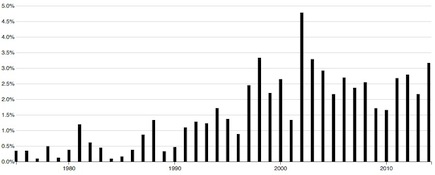
Second-wave feminists initially brought attention to the body and its feminist politics in the 1960s (think, for example, of Our Bodies, Ourselves ). Nevertheless, I was not surprised to see that in Signs articles about the body only start to pick up in the late 1980s and early 1990s. It was about then that feminist scholars began to identify conditions of embodiment as the principal means through which inequality between the sexes is produced, justified, and sustained. After all, as Françoise Héritier-Augé (1989) pointed out, biology was one of the primary justifications given to explain the persistent domination of men over women. If men were biologically stronger than women or evolutionary adapted to hunt and protect, than perhaps gender inequities were just part of the natural order. The social and cultural meanings assigned to bodies thus became implicated in a broader feminist political project of understanding the origins and maintenance of patriarchal rule.
It is for this reason that, at least in early iterations of this digital project, the term body often coincided with the term difference in Signs's archives. This got me thinking: the scholarship on the body and difference has been profoundly important in demonstrating the perniciousness of gender in the making of knowledge on the body. Take, for example, Judith Butler's (1993) extraordinarily influential book Bodies That Matter, in which she argues that although bodies are material (and, therefore, "real"), they can only be understood through the discursive power of heterosexual hegemony. In other words, what we know about men and women's bodies is largely determined by how we think of men and women as different, more generally.


Signs has a proud tradition of publishing feminist science studies that illustrates the role of gender in the making of knowledge. One of the most famous and most important of these studies comes from Emily Martin's (1991) classic Signs article on the egg and the sperm. This piece convincingly argues that biology textbooks regularly depict sex cells as engaged in a traditional romance, wherein the egg lounges around waiting to be saved by the brave and valiant sperm. And yet, as Martin points out, this ubiquitous cultural depiction poorly represents what seems actually to happen during conception, in which an egg actively engaged in a process that attracts aimless sperm.
Martin's article endures because it cleverly subverts common sense about the body, revealing how everyday assumptions about sex difference color basic knowledge about reproduction. Sarah Richardson (2013) carries on this tradition in her recent article, "Sexing the X," in which she asks how we have come to associate the X chromosome with females even though both men and women possess at least one. Her analysis traces this relationship back to historically contingent events in the early twentieth century and further demonstrates the way that gender ideology can bias and mislead scientific knowledge production. But the power of her argument really lies in the way it makes readers immediately stop and wonder why they ever believed something that is so obviously wrong. Articles like these have uncovered the epistemological consequences of making assumptions about gender difference and the body.
Scholars in Signs have also recognized that it is not enough to just critique the gender assumptions underlying knowledge about the body. We must also develop models to understand how culture interacts with the body, which - after all - is fundamentally material. In "The Bare Bones of Sex," Anne Fausto-Sterling (2005) provides a particularly useful model for thinking through the relative contributions of biology and culture when it comes to sex difference. Using bone development as a case study, Fausto-Sterling's model nests biological determinants of bone strength, like pattern genes and growth hormones, with cultural mediators, like the kinds of sports that an individual plays and that person's diet. This model gives the rest of us a way to understand and explain gender differences in the body.
It's clear from this digital project that Signs has been pivotal in developing foundational work on feminist science studies and the body. But what can digital humanities tell us about ways to move forward? One potential avenue might be to move beyond gender difference in studies of science and the body and, instead, investigate similarities across men and women's bodies. After all, as Asia Friedman (2013) argues in her recent book Blind to Sameness, men and women have many more shared characteristics than distinguishing ones. And yet, we think of men and women as two very different sorts of creatures.
Thus, it might be analytically productive to brainstorm the kinds of research questions that emerge if we start to think about men and women's bodies as more similar than they are different. Feminist scholars have already begun to think through this possibility. Rene Almeling and Miranda Waggoner (2013), for example, suggest that by emphasizing gender differences, we have accidentally excluded men from analyses of reproduction. They point out that men, in fact, contribute a great deal to reproduction, from their genetics to preconception behaviors to sex cells to their behaviors during partners' gestation. To ignore their contribution is to run the risk of assigning women the entirety of reproductive responsibility and biological risk, from contraception (see, e.g., the absence of a male pill, Oudshoorn 2003) to what constitutes responsible behaviors before and during gestation (see, e.g., alcohol abuse among fathers, Armstrong 2003) to parenting.
Feminist scholars have done excellent work in exposing how biomedical knowledge can reify and perpetuate social differences. We must now expand this inquiry to see what happens when we consider similarities across the sexes.
Joanna Kempner is assistant professor in the Department of Sociology at Rutgers University and an Associate Editor of Signs. Her recent book is Not Tonight: Migraine and the Politics of Gender and Health.
References
Almeling, Rene, and Miranda R. Waggoner. 2013. "More and Less than Equal: How Men Factor in the Reproductive Equation." Gender & Society 27(6):822-42.
Armstrong, Elizabeth M. 2003. Conceiving Risk, Bearing Responsibility: Fetal Alcohol Syndrome and the Diagnosis of Moral Disorder Baltimore: Johns Hopkins University Press.
Butler, Judith. 1993. Bodies That Matter: On the Discursive Limits of "Sex." New York: Routledge.
Fausto-Sterling, Anne. 2005. "The Bare Bones of Sex: Part 1—Sex and Gender." Signs: Journal of Women in Culture and Society 30(2):1491-1527.
Friedman, Asia. 2013. Blind to Sameness: Sexpectations and the Social Construction of Male and Female Bodies. Chicago: University of Chicago Press.
Héritier-Augé, Françoise. 1989. "Semen and Blood: Some Ancient Theories Concerning Their Genesis and Relationship." Translated by Tina Jolas. In Fragments for a History of the Human Body, vol. 3, ed. Michel Feher with Ramona Nadoff and Nadia Tazi, 159-75. New York: Zone.
Kessler, Suzanne J. 1990. "The Medical Construction of Gender: Case Management of Intersexed Infants." Signs 16(1):3-26.
Markowitz, Sally. 2001. "Pelvic Politics: Sexual Dimorphism and Racial Difference." Signs 26(2):389-414.
Martin, Emily. 1991. "The Egg and the Sperm: How Science Has Constructed a Romance Based on Stereotypical Male-Female Roles." Signs 16(3):485-501.
Oudshoorn, Nelly. 2003. The Male Pill: A Biography of a Technology in the Making. Durham, NC: Duke University Press.
Richardson, Sarah S. 2012. "Sexing the X: How the X Chromosome Became the 'Female Chromosome.'" Signs 37(4):909-33.
Covering Art: A Very Brief History of the Signs Covers
Susan Sidlauskas
When Signs was young, its cover was somber: white letters of faintly archaic typeface centered perfectly from top to bottom on a black ground. Anchoring the cover was a graphic that hovered between the decorative and the scientific—a grid arranged like a tic-tac-toe board, with black squares around white circles, or circles piercing squares, depending upon how long you stared at it. The Signs of the 1970s could easily keep company with the law and engineering print journals that once filled the display shelves of our libraries. But of course you can't always tell a book by its cover. That austerity was a deflection rather than a sign, masking the vital, controversial essays gathered inside. Volume 1, no. 1's contents—with contributions by Carroll Smith-Rosenberg, Julia Kristeva, and Elizabeth Hardwick, just to name three of the distinguished authors—would become landmarks in the history of feminism.
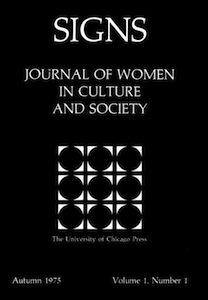
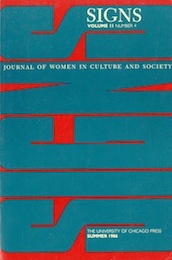
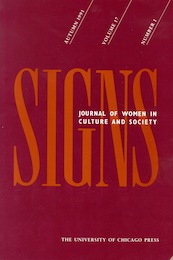
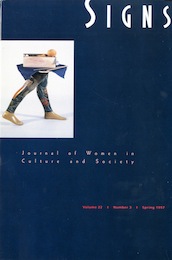
A full cover art gallery is available here.
Graphic experimentation grew bolder. In the 1980s, the Signs title shed its decorous restraint, as it was turned on its side, with its geometry softened and swelled, as if to burst the cover's bounds. The 1990s saw a jazzy treatment in which tall narrow letters took on the aspect of dancing skyscrapers. But everything changed later in that decade when the editorial board decided that works by living women artists-a different image for every quarterly issue-would grace the covers of Signs from then on.
Gone (1994), by the young African American artist Kara Walker, was one of the earliest choices (Autumn 1997), the cover illustration for an issue focused on race and difference. This was an episode from the very first of Walker's pathbreaking installations of black silhouettes, cut from paper and pressed onto white walls. The full title of the piece, based on Margaret Mitchell's Gone with the Wind, which Walker found both "engrossing and grotesque," is Gone, An Historical Romance of a Civil War as it Occurred between the Dusky Thighs of One Young Negress and Her Heart. The artist, whose young adulthood had been spent in Atlanta, found that Mitchell's novel, and the film it inspired, concentrated her search to convey what she called the "this bizarre construct of racism."

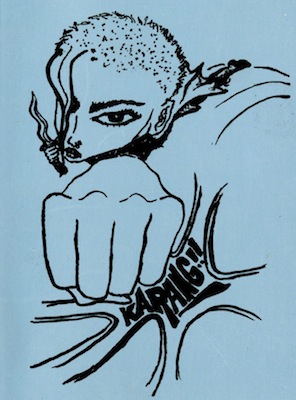
Spring of the next year brought another visual shock from a young woman of color. The issue dedicated to feminisms and youth culture was graced by the bold graphic Bamboo Girl in Action, a confrontational self-portrait in which the artist, a self-described "queer Filipina Mestizo," throws a punch at her audience. The name of Sabina Margarita Sandata's zine, "by/for/but not exclusive for the young loud women of color," is Bamboo Girl. Here we see the author/editor/artist in full action mode, with her diminutive chin, seductive eyes, and shorn hair receding into the distance behind a huge left fist that hurtles right toward us. Her right hand clutches a knife with a dangerous looking serpentine blade, a testament to Sandata's expertise in Pananandata, the Filipino martial art of weapon fighting.
Some future covers would be themselves performative: the two-part piece that would announce Part I and Part II of the issues dedicated to War and Terror (2007). The Polish painter, filmmaker, photographer, and installation artist Bogna Burska provided illustrations for a cluster of essays on themes of bioterrorism and anthrax, "degendering" in the military, civil war, and the religious right. At first, both covers seem to be the same design, with their colors simply inverted. Smears of red paint on a white, and then a black ground. But as we look at them and compare the two near-abstract images, we see that they are quite different, a recognition that causes us to study them even more carefully. The "clotted bloodstains" of Burska's paintings, as she calls them, are painted directly with fingers on a surface—whether that is a wall, cotton cloth, paper, or glass. The smears of red paint are not only visceral, striking abstractions but are the messy confluence of dozens of red handprints—some of a scale associated with a child. And the lighter red on white image turns out to be even more disturbing than the red on black.

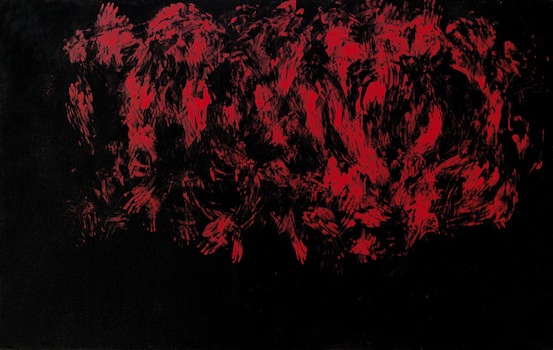
Leslie Lawrence, a writer of fiction and memoir, contributes a beautiful photograph to the cover of an issue on Women in Agriculture (2009), which includes essays on the economic and political struggles of women who farm in Nicaragua, Sri Lanka, and Chile. The image shows three lively Indian women wearing full-length saris standing in a terra cotta field under a violet sky. But this appealing, reassuring image has been framed by a cover of acidic greenish yellow, a dissonance that jolts us into remembering that the generic scene of the happy third-world farmworker is a myth.

Ghosts haunt the covers of Signs. Francesca Woodman's elegiac photograph series, Study for Space , which was produced from 1975 to 1978, reminds us of all the work that did not get done by this talented young woman who took her own life shortly after these images were made. Jinn (2003), by the London-based artist Zineb Sedira is a transparent white spectre that almost materializes upon the black void of the cover devoted to New Feminist Theories of Visual Culture. At first, the translucent gloves that float upon the black cover of an issue that contained a symposium on Gender and Medical Tourism (2011) seem like the kind of accessory that Emily Dickinson might have worn: lacy, long, with delicate buttons too tiny to be closed without a hook. But then we see that the edges of these "gloves" are suspiciously ragged, and it turns out that what our eyes recognized as "lace" is in fact the texture of the human skin on which these pieces were cast. Artist Laura Splan uses her own body-blood and facial peels-to "subvert the familiar and the benign." These delicate but disturbing skin peels adorned with ladylike fasteners are the perfect harbinger for a symposium that considered the international quest for surgical "beauty."
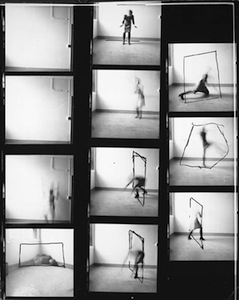
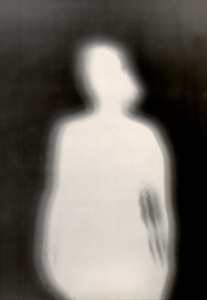
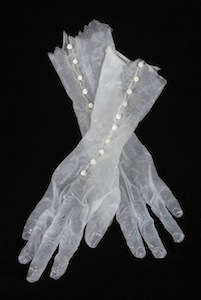
To my mind, the most arresting marriage of form and content among the art chosen for the Signs covers is the image that announces the special issue on Women, Gender, and Prison (2013). A collaboration between two women incarcerated in an Alabama state prison, Toni Bowers and Natasha Ward, the piece, as we see it, combines lyrical chalk-white handprints and bold patterns on black with a photograph of the graceful brown hand of one of the woman who produced it, fluidly incorporated into, but distinct from, the production. Bowers and Ward have found a genuine satisfaction in an innovative program—the Arts and Education Project—that takes place within the Alabama prison. Ward's biography notes that participating in the program "helped out on her feelings, her mind, and her life." And Bowers's summary of the significance of the art program to her life in prison includes her affirmation that "It's not just what awaits you on the other side. It's all about the climb."
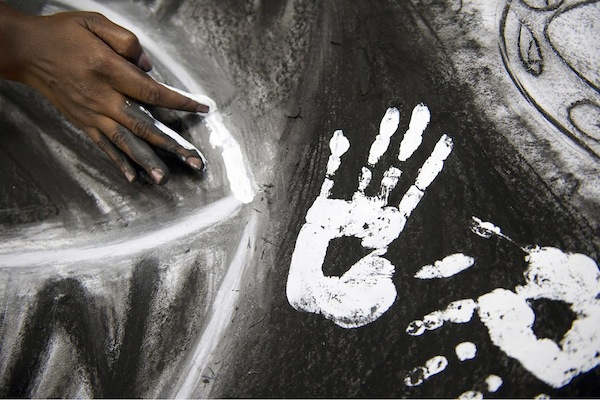
Susan Sidlauskas is Professor of Art History at Rutgers University and an Associate Editor of Signs. In 2014 she was awarded a John Simon Guggenheim Memorial Fellowship.
From Noun to Verb: Writing about Writing about Writing in Signs
Agatha Beins
Without additional context, the word writing invites grammatical ambiguity. Is it a noun or a verb? Is it a gerund or a present participle? Is it modified by a helping verb, or does it wish for a noun to modify, as in "the writing book," wherein we presume there is a book about writing? With accompanying words like narrative, text, story, book, reading, texts, work, and voice, the Writing topic suggests that in Signs, writing is most likely a noun. Writing is an object: that-which-has-been-written. Even a brief perusal of the top articles in this topic, however, indicates that writing is far from a static product. Tracing the Writing topic from what the list overview presents through the different algorithmic representations in this Signs archive, in this essay I return that-which-has-been-written to the grammar of an action. While I recognize that my brief investigation of writing about writing in Signs leaves an incredible wealth of data untouched, I take two approaches to the product-practice dynamic I identify: an examination of this topic's nuances using several of the top listed articles and a survey of the topic across time.

Publications about the founding moments of women's studies indicate that academics who first started teaching in this field worked primarily in the humanities (see, e.g., Howe 2001). Since English faculty made up a significant portion of these scholars, perhaps not surprisingly the kind of writing made prominent by the Writing topic appears to be creative writing. Consider the top document in this topic, "Deviant Classics: Pulps and the Making of Lesbian Print Culture" by Stephanie Foote (2005), which begins with Ann Bannon's Beebo Brinker. While ostensibly about reading practices, the second top document, "Space Travel: The Connective Politics of Feminist Reading," opens with the novel Tender Mercies by Rosellen Brown (Gwin 1996, 870). Minrose Gwin goes on to analyze narrative prose by women, a category that comprises fiction and autobiographical accounts as well as texts that synthesize both genres (871). Moreover, the only other topic with writing appearing in the list overview, contains words like Woolf, literary, female, criticism, literature, writers, work, feminist, and fiction. This small sample characterizes the kind of written work we can expect to find within the Writing topic, though it encompasses a potentially eclectic range, from fiction to nonfiction and from the conventionally high literature like that by Virginia Woolf to the conventionally lowbrow pulp publications.
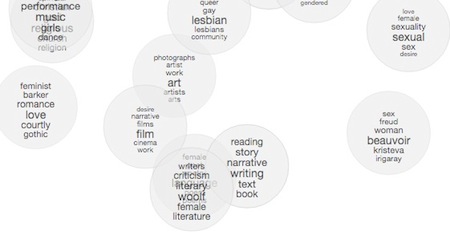
Shifting to a different mode of data presentation, the Topic Space subview, we see the Writing topic at the bottom of the assemblage, a circle at the end of a short tail of topics related to cultural productions (topics labeled Film, Poetry , Literary Criticism, and Visual Art). Despite having almost no discursive overlap, the Poetry and Writing topics share significant spatial overlap in this subview of the model, perhaps a transitive effect of the strong connection that the Literary Criticism topic has with both Writing and Poetry. These topics thus evidence a heavy pull, bringing Writing into their orbit and away from the next closest circle, the third and last topic that also includes writing as a top word (the topic labeled French Feminism). Several shared words (writing, text, work, language, and essay) between Writing and French Feminism provide only a weak link, not enough to overcome the gravity of Film, Poetry, Literary Criticism, and Art. The Topic Space subview thus also reinforces writing as a written product placed within a creative genre.
Let us now move to the "creative" part of "creative writing" with the next two top documents for the Writing topic. "Remembering the Future; or, Whatever Happened to Re-Vision?" by Liedeke Plate (2008) diverges from the focus on fiction in Foote's and Gwin's articles. Adrienne Rich's essay, "When We Dead Awaken: Writing as Re-Vision" (1972), serves as the launching point for Plate, who explores the relationship between how we rewrite the past and how we envision the future. Also focusing on writing as a site of knowledge production, Suzanne Fleischman propels her analysis of the language women use in their professional writing with the question "How can women create the stories of women's lives?" (1998, 975).
Though my sample size is small and my sampling informal, the top documents for this topic allow us to see writing as creative and to see creative not just as innovative but as productive: that which creates knowledge, that which creates culture, that which creates truths. For instance, in her analysis of feminist writing about the past, Plate implies that all writing is re-vision. Each presentation of history, after all, is an interpretation of evidence and thus a re-presentation of the meaning and significance of these artifacts. Reading further in Foote's article about lesbian pulp novels shows that in my attention to the kind of writing she studies I glossed over her analytical intervention, namely to explore "how pulps … have helped to create a lesbian print culture" (2005, 170). Again, that-which-has-been-written refuses passivity and objecthood. This quality also pushes us to question the directionality of writing. That is, instead of provoking only close reading, writing about writing in Signs encourages us to move outward from a text, to investigate both the context of its past and its implications for the future.
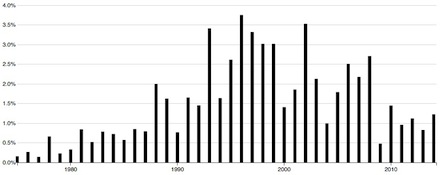
Tracing the trajectory of the Writing topic across time adds another dimension to the product-practice tension that writing embodies. I looked at the period of publishing between 1993 and 2002, when this topic has its strongest presence. One reason for this prominence is special issues. Summer 1993 brings with it "Theorizing Lesbian Experience," in summer 1996 the special issue topic is "Feminist Theory and Practice," and "Gender and Cultural Memory" is the theme in fall 2002. The special issues include over half of the top twenty articles in 1993 and 2002 and almost a third of the top articles in 1996. Without question, they shaped the wax and wane of this topic in Signs—as special issues do for many topics explored here—yet I was surprised that none of these themes seems to suggest a particular focus on writing, or, rather, none seems to suggest a particular focus on that-which-has-been-written. Two of the special issues explicitly foreground actions, practice and theorizing, and so if we recognize writing as an action or as a force that creates, then it makes more sense to find writing appearing at these times.
I offer one additional hypothesis about the overall temporal path of Writing as a topic in Signs. As someone who studies print culture and history of the book, I am interested written products as well as processes of production. In the mid-1990s computers and the Internet became increasingly accessible to the general public; they also became more salient sites of cultural production, mediating and facilitating our writing and other creative projects. I couldn't help but wonder how this shift in process and form may be tied to a rise in writing about writing, since questions about the role of printed and digital media in society can draw attention to a wider range of texts for scholarly analysis. While my query may move us beyond the confines of this digital humanities project, closer investigation of the spread of particular topics over time and within particular years could provide some data to explore this conjecture.
Though cursory, the chance to explore writing about writing in Signs has brought forth for me exciting revelations and paths to pursue for future investigation. First, it illuminated the ways in which Signs articles foreground the temporal, spatial, practical, historical, and political dimensions of written products, pushing readers to recognize that writing is an effect at the same time that it produces effects, and these effects extend beyond the meanings close readings and literary criticism produce. Additionally, through their focus on writing, the articles in the Writing topic indicate that one of the actions of writing is epistemological. Writing becomes a way to question what we know, how we know, and how we can know differently. Consider Patti Lather's article (fifth in the top document list), which integrates social sciences into this conversation by interrogating "the thinking that writing produces" (2001, 200) from the perspective of an ethnographer. Although epistemology does not appear in the word list for the Writing topic (interestingly, only one topic contains this term), it seems to be one of the "frameworks of enunciability" for Signs more generally (this phrase builds on Maylei Blackwell's discussion of the "conditions of enunciability" in her analysis of Chicana feminist activism [2011, 15]). I'm therefore curious what this digitized data set reveals (and obscures) about epistemology as a meta-analytic. Over the past forty years Signs has challenged, ruptured, contested, re-imagined, and politicized epistemological frameworks through the articles published. Simultaneously the journal's editorial and peer review processes have bolstered certain epistemologies as feminist, one of which, as I suggest here, is the boundary-transgressing, dynamic grammatical construction of writing.
Agatha Beins is assistant professor in the Department of Women's Studies at Texas Woman's University. She is the Editor of Films for the Feminist Classroom.
References
Blackwell, Maylei. 2011. ¡Chicana Power! Contested Histories of Feminism in the Chicano Movement. Austin: University of Texas Press.
Fleischman, Suzanne. 1998. "Gender, the Personal, and the Voice of Scholarship: A Viewpoint." Signs: Journal of Women in Culture and Society 23(4):975–1016.
Foote, Stephanie. 2005. "Deviant Classics: Pulps and the Making of Lesbian Print Culture." Signs 31(1):169–90.
Gwin, Minrose. 1996. "Space Travel: The Connective Politics of Feminist Reading." Signs 21(4):870–905.
Howe, Florence, ed. 2001. The Politics of Women's Studies: Testimony of Thirty Founding Mothers. New York: The Feminist Press.
Lather, Patti. 2001. "Postbook: Working the Ruins of Feminist Ethnography." Signs 27(1):199–227.
Plate, Liedeke. 2008. "Remembering the Future; or, Whatever Happened to Re-Vision?" Signs 33(2):389–411.
Rich. Adrienne. 1972. "When We Dead Awaken: Writing as Re-Vision." College English 34(1):18–30.
Mapping Black Feminist Genealogies: Toward New Models
Brittney Cooper
For forty years, Signs has provided the tools for us to imagine, conceptualize, reimagine, and reconceptualize the endless possibilities of feminist theorizing. These new and innovative topic models are most fascinating for the ways they push us to rethink the broad intellectual histories and genealogies of feminism, making remarkably generative connections and conceptual linkages among articles and topics.
I approached the topic models with questions about works that have appeared in Signs under the loose topic of Black feminism. I therefore began with the topic that aggregates words like black, white, race, racism, African, and American. The top articles within this topic have become nothing short of classic within the field of Black feminist thought. Most, including Evelyn Brooks Higginbotham's "African-American Women's History and the Metalanguage of Race" (1992), Elsa Barkley Brown's "Womanist Consciousness: Maggie Lena Walker and the Independent Order of Saint Luke" (1989), Deborah King's, "Multiple Jeopardy, Multiple Consciousness: The Context of a Black Feminist Ideology" (1988), and Patricia Hill Collins's "The Social Construction of Black Feminist Thought" (1989), suggest that much of the early academic groundwork for Black feminist theory came from the fields of history and sociology. While I am quite familiar with all of these works, these topic models provide a visual of key disciplinary connections among the fields of history, sociology, and literary studies in creating academic Black feminism.
However, I also examined several of the top articles in the Black Feminism topic to see what other topics were significantly represented within their contents. There a very different picture emerged, one that I think is most significant for how scholars might think about teaching these texts.
For instance, it makes complete sense to teach Higginbotham's "Metalanguage" alongside Brown's "Womanist Consciousness" because they are two groundbreaking texts in the field in of African American women's history. But when I compared the top five topics for Higginbotham, Brown, and King's "Multiple Jeopardy, Multiple Consciousness," Brown and King unexpectedly shared four topics in the top five (the topics labeled Black Feminism, The Social, Political Movements, and Women's Roles)! Higginbotham and Brown only shared three, which is not insignificant, and Higginbotham and King shared two in common. This kind of comparison suggests that in teaching a Black feminist theory course, I might pair Bonnie Thornton Dill's 1979 essay "The Dialectics of Black Womanhood," with Shatema Threadcraft's 2014 essay "Intimate Injustice, Political Obligation, and the Dark Ghetto," because they share three topics in common (Black Feminism, The Social, The Family).
In mapping the topic frequencies between these essays, seven of the top articles under the Black Feminism topic also had The Social (which aggregates words like social, power, experience, process, community, and relations) within their top five topics. This suggests that in teaching it might be interesting to pair articles in Black Feminism with articles in The Social. It bears noting though, that The Social is a very broad topic, enjoying a significant share of the words in the corpus of texts. This might be a deterrent for some, but I think this topic might serve as a kind of main highway that allows us to make connections between many other texts, which we otherwise would not link. Moreover, being able to use top five shared topic frequencies to generate other kinds of spatial grids and to demonstrate other relationships among the topics and the articles under those topics would be supremely useful.
Next I turned to the topic labeled Feminist Movements. Under this topic important pieces emerge in thinking about Black feminism's connection to the third wave, including Kimberly Springer's essay "Third Wave Black Feminism?" (2002) and Beverly Guy-Sheftall's (2002) comment on it.
I was actually surprised to discover that intersection, intersectional, and intersectionality were not aggregated into a topic. Because intersectionality has been the most visible analytic to emerge from women's and gender studies since its advent by Kimberlé Williams Crenshaw in 1989, it is a term that enjoys what Robyn Wiegman (2012, 240) has called "citational ubiquity." Thus it seems very important to map the vast number of works that use intersectional frames but also to provide a conceptual universe of words that appear near, around, or next to intersectionality within articles. Several of the most recent articles on intersectionality proper show up as top articles under the topic that aggregates words like difference, discourse, identity, and culture .
On the one hand, the absence of an intersectional model (pun seriously not intended!) forces us to think more deliberately about all the places where intersectional work lives within the broad conceptual universe of feminist theory. That is, I think, a good thing.
But as a theoretical, analytic, and political intervention that emerges from Black feminism, intersectionality matters significantly for understanding feminist theorizing over the last forty years, and for mapping Signs' important contributions to moving the conversation forward. I consider this a real oversight, and I hope future models will be built to account for intersectionality specifically.
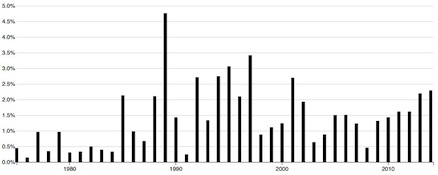
What is perhaps most interesting is that these topic models resist our desire to put intellectual traditions into easy categories of trends over time. Looking at the graphs for Black Feminism and The Social might suggest that the "best" year for works in Black feminism was 1989. But looking at these graphs as visuals that tell us something about the birth of new conceptual universes, that shift and change over time, reaggregating in interesting ways, presents a picture of Black feminism that is dynamic rather than static. Still, it is concerning that there has been a steady decline in articles that fit within this topic since 1989, though the resurgence since 2010 is promising.
The topic model illustrates that Black feminism, like so many other areas of feminist inquiry, defies easy categorization under only one, or even two topics. Figuring out the other topical universes in which works in Black feminism exist is something I will explore more on the site and something that would provide an interesting pedagogical opportunity for students. But what has also become abundantly clear in my interactions with these models is the unparalleled importance of Signs to the intellectual genealogy of Black feminist thought.
Brittney Cooper is assistant professor of Women's Studies and Africana Studies at Rutgers University. She is a member of the Crunk Feminist Collective.
References
Brown, Elsa Barkley. 1989."Womanist Consciousness: Maggie Lena Walker and the Independent Order of Saint Luke." Signs: Journal of Women in Culture and Society 14(3):610-33.
Collins, Patricia Hill. 1989. "The Social Construction of Black Feminist Thought." Signs 14(4):745-73.
Crenshaw, Kimberlé Williams. 1989. "Demarginalizing the Intersection of Race and Sex: A Black Feminist Critique of Antidiscrimination Doctrine, Feminist Theory and Antiracist Politics." University of Chicago Legal Forum 1989: 139-67.
Dill, Bonnie Thornton. 1979. "The Dialectics of Black Womanhood." Signs 4(3):543-55.
Guy-Sheftall, Beverly. 2002."Response from a 'Second Waver' to Kimberly Springer's 'Third Wave Black Feminism?" Signs 27(4):1091-94.
Higginbotham, Evelyn Brooks. 1992. "African-American Women's History and the Metalanguage of Race." Signs 17(2):251-74.
King, Deborah K. 1988."Multiple Jeopardy, Multiple Consciousness: The Context of a Black Feminist Ideology." Signs 14(1):42-72.
Springer, Kimberly. 2002. "Third Wave Black Feminism?" Signs 27(4):1059-82.
Threadcraft, Shatema. 2014. "Intimate Injustice, Political Obligation, and the Dark Ghetto." Signs 39(3):735-60.
Wiegman, Robyn. 2012. Object Lessons. Durham, NC: Duke University Press.
Signs, Archives, and Libraries
Kayo Denda
"Crowds roar. Ticker tape falls. [SIGNS] becomes official" (Stimpson 1974). In the forty years since Catharine Stimpson, founding editor of Signs, wrote these enthusiastic words to Jean Sacks, manager of the Journals Division at the University of Chicago Press, Signs and the world have undergone dramatic changes with the rise of digital technology. The angular waves of the stream-graph capture variations of feminist intellectual labor and knowledge production through time and space. The exquisite image also embodies advances in computer-mediated techniques that render images reflecting complex relationships of words and families of words. These new generations of digital tools open new possibilities, altering traditional methodologies with potential for new pedagogies while increasing accessibility to scholarship for broader audiences.
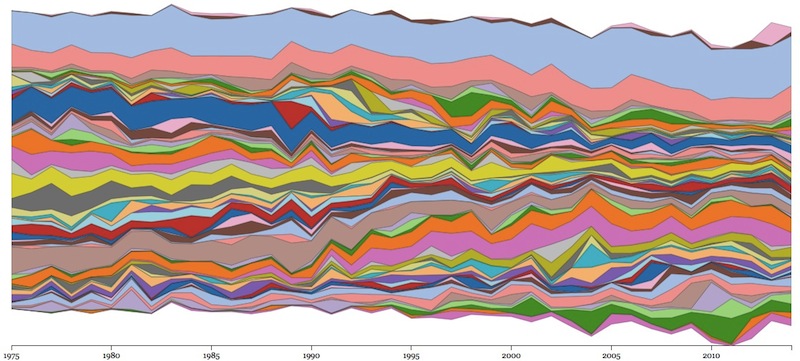
Examining the families of words generated by topic modeling, the terms library and archives appear in the topics labeled Information Technology and US Women's History. Their inclusion legitimizes libraries and archives as players with central roles in feminist scholarship published in Signs, thus contributing actively in the process of institutionalization of the field of women's and gender studies. Their presence also reveals a broad vision and commitment by journal editors to an interdisciplinary journal with broad representation.
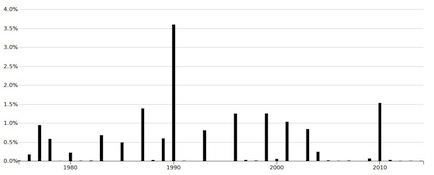
The Information Technology topic includes words such as computer, technology, language, information, library, system, and typewriter. These different forms of technology, technology-mediated fields, and digital contents have altered legacy practices, destabilizing traditional operations not only in libraries and archives but in all aspects of society. The distribution of this topic over time has been sparse but continuous in terms of yearly proportion. It peaked in 1990, with the special issue "From Hard Drive to Software: Gender, Computers, and Difference" (Signs 1990). The term with most weight in the topic is computer, and the top document is a feminist critique of the neutrality of systems of classification in libraries and archives and their claim of universal representation. Other documents discuss computer culture, computers and the politics of gender identity, virtual reality, and cyberfeminism. Overall, these essays discuss the impact of technology, from typewriters to cyberspace, on the lives of women and men and analyze the complexities of power dynamics mediated by technology over the last forty years. Going forward, as new generations of feminist digital humanists focus on different manifestations of technology and engage in their critique, it is possible that upcoming iterations of this topic might include terms such as digital, network, and Tweet, generating new relationships and infinite possibilities.
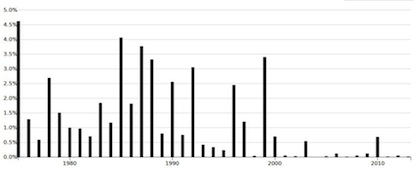
In contrast to the Information Technology topic, the US Women's History topic displays a very different path. It was well represented from 1975 throughout the 1990s, but it has almost disappeared after 2000. This topic includes the words American, suffrage, nineteenth, papers, Boston, letters, England, sister, library, and club in addition to archives. Although anecdotal, this collection of words suggests a significant body of historical research focused on nineteenth-century Anglo-American women using records and archival collections. The notable presence of this topic in the first decades of Signs might reflect the priorities articulated by Stimpson and her editorial office, especially their commitment to making visible hidden histories of women and other histories that could not be forgotten. The Signs Archives section was an example of innovative initiatives of the journal. The section included essays on specific archives and investigations on American women leaders, including their unpublished letters and speeches; it also offered overviews of accomplished international women, such as Berta Lutz, a Brazilian suffrage movement leader in the first decades of the twentieth century (Hahner 1979). The Archives section was discontinued in the early 1980s, coinciding with the time when the scholarship on women and gender increased, and commercial indexing such as the Studies on Women Abstracts, designed to meet the information needs of librarians and scholars, became available, thus providing increasing access to resources on women.
Although not explicitly represented in the family of words in this topic, the Archives section also brought attention to African American women as exemplified by the report on "Early Archives Committee of the National Council of Negro Women" (Henry 1981), promoting historical awareness and inspiring new investigations. In spite of this essay, the family of words in this topic makes no reference to race, ethnicity, or gender. Without question, this scenario suggests an overwhelming presence of archives on Anglo-American women compared to those on women from different backgrounds, a situation that cultural institutions have only recently attempted to address. Libraries and archives have started to focus their attention on collecting and preserving histories of traditionally marginalized populations. Building robust collections of oral histories of women from immigrant and diasporic communities or LGBTQ communities are welcome initiatives for librarians and archivists to undertake. These collections would most likely serve as rich resources for innovative teaching and research, while changing the dynamics of this topic.
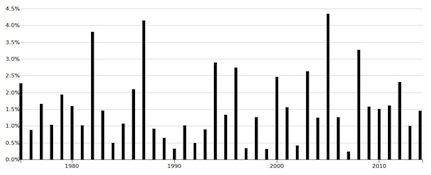
Some topics, such as the topic labeled Field of Women's Studies, do not explicitly include the word library; however, the family of words displays an intrinsic affinity with libraries and the work of librarians. This topic includes words such as studies, feminist, work, research, scholarship, academic, field, and knowledge, among others, and their implicit relationship with library resources and collections is discernible. The topic has remained constant, with robust presence from the 1970s to the present, embodying the deep relationship that continues today between academic library research collections and scholars in the field of women’s and gender studies. The top document listed under this topic discusses the bibliographies for research on women (Ballou 1977). Other documents listed include research and reports on research focused on women in the United States and around the world, organized in the "United States Notes" and "International Notes" sections of the journal respectively. In the first few years, the "New Scholarship: Review Essays" section included overviews on new scholarship on women in the disciplines, from the fields of psychology, political science, sociology, economics, population studies, natural sciences, classics, literature, religions, and philosophy, among others. This section served as a vehicle to disseminate existing research and related resources in order to alter established theory and methods and to generate a more nuanced understanding of individuals and societies.
The recognition of archives as one of the central sites for feminist scholarship might have worked in favor of Rutgers University Libraries, which received the "Signs Records" as a gift from the University of Chicago Press in 1987. Since then, the Rutgers, Special Collections and University Archives have been the journal’s archival repository (King 1987). The Signs Records encapsulate the original vision, strategies, challenges, and polemical debates, including the intense process of the naming of the journal in the early years. More recently, the records have supported feminist investigations and many studies focusing on different political and social forces that shaped the narratives of feminist scholarship.
Since the establishment of Signs, libraries and archives have dramatically changed with the impact of digital technologies. Many collections, such as the CWGL poster collection, a digital collection of posters published by women activists around the world and collected by the Rutgers Center for Women’s Global Leadership, are available for a broader audience worldwide. The challenge now is how to preserve rich born-digital and interactive resources, such as the stream-graph and other components of Signs topic mapping. At Rutgers Libraries, the RUcore: Rutgers Community Repository can ingest and preserve components of topic mapping for archival and preservation purposes. However, these practices in many ways continue the traditional concept of archive as a representation of the past and not a site for new explorations.
Looking forward, what is the framework archives and libraries must aspire to for greater impact in feminist and digital humanities scholars? Many leaders in library and information science fields have called for a recalibration of libraries, crafting a new role for libraries and librarians as active participants in knowledge production and engagement in the digital age. This new digital era calls for a reformulation of approaches to library practices as a feminist practice. A new paradigm deviating from the tradition of collecting and storing, as well as the dynamics of discipline and control—the bases of library organization—requires reimagined libraries and librarians. A reimagined librarian would welcome ambiguity and interactivity, resist oppressive norms of dominance and control, understand situated knowledge, and engage in ambitious collaborations with campus partners. As this paradigm becomes a reality and libraries flourish in a digital ecosystem, we will have a reason to celebrate and watch the crowd roar and ticker tape fall.
Kayo Denda is head of the Margery Somers Foster Center and Women's Studies Librarian, Rutgers University.
References
Ballou, Patricia K. 1977. "Bibliographies for Research on Women." Signs: Journal of Women in Culture and Society 3(2):436-–50.
Hahner, June E. 1979. "The Beginnings of the Suffrage Movements in Brazil." Signs: Journal of Women in Culture and Society 5(1):200–204.
Henry, Linda J. 1981. "Promoting Historical Consciousness: the Early Archives Committee of the National Council of Negro Women." Signs 7(1):251–59.
King, Albert C. 1987. "Manuscript Acquisitions." Journal of Rutgers University Libraries 49(1):50–55.
Signs: Journal of Women in Culture and Society, ed. 1990. "From Hard Drive to Software: Gender, Computers, and Software." Special issue of Signs 16(1).
Stimpson, Catharine. 1974. Letter to Jean Sacks at University of Chicago Press, November 21. Folder "more Early SIGNS" Box 1, MC 652, Signs: Journal of Women in Culture in Society Records, Special Collections and University Archives, Rutgers University Libraries.
Exploring the Chronology and Intertextuality of Feminist Scholarship on Central and Eastern Europe
Magdalena Grabowska
While humanities and social science scholars do not avoid quantitative research methods, we are not all accustomed to seeing our own work represented in the rigorous form of statistics and charts. Therefore to write an editorial comment for the Signs fortieth anniversary site posed quite a challenge. The site and the topic model developed by the Signs team illustrate the crucial transformation in our field, one that spans both the content and practice of humanities research. The emergence of digital technologies, and the increasingly crucial role they play in the humanities and social sciences, opens up new fields of study, generates new research questions, and transcends traditional disciplinary boundaries.
For this short comment I have examined three aspects of the Signs topic model in terms of their usability for analyzing scholarship on Central and Eastern Europe: as a method for creating individual archives that trace a changing scope and direction of the field, as a methodological framework for examining correlations between Central and Eastern Europe and other fields within women's and gender studies, and as a critical tool that can help to reveal the gaps within the feminist knowledge production processes.
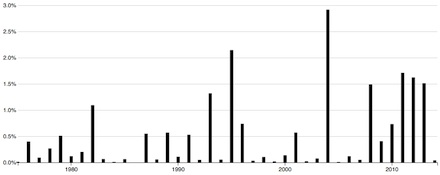
I began my exploration by looking at the chronology of the articles published within the topic labeled Central and Eastern Europe. Confronting the massive body of texts and possible ways of navigating it was overwhelming at first, but my reaction was positive. I found that the model could be useful in interactively examining the emergence and expansion of state- and post-state-socialist studies as both an academic field on its own right and an area of studies that intersect with other topics crucial to feminists scholarship. At the most basic level, the model reveals how feminist scholarship on Central and Eastern Europe evolved from analyses that focused on women's history in comparative perspective to the call for a critical assessment of the use of Western frames to an examination of post-state-socialist contexts. While initial articles published in Signs between 1975 and 1985 focused on assessing women's equality in Soviet Bloc from the perspective of the West or the global women's movement, in the 1980s looking for the legacies at work in the region and providing detailed analyses of the local forces that led to the major global events, such as the Russian Revolution, became a primary focus of articles such as Barbara Evans Clements's "Working-Class and Peasant Women in the Russian Revolution, 1917-1923" (1982)
The ambivalent effects of transformations in women's rights in Central and Eastern Europe became a crucial preoccupation in the 1990s. Articles including Dorothy J. Rosenberg's "Shock Therapy: GDR Women in Transition from a Socialist Welfare State to a Social Market Economy" (1991) delineated some of the paradoxes of peaceful revolutions and argued that while they brought back a wide array of democratic freedoms, including the rights to organize and free speech, they also deprived women of certain social rights, including affordable housing, employment, and free medical care. A closer look at these accounts of the dubious effects of the post-1989 transformations reveals that they are mostly narrated within the frames of Western and US feminist theory and practice. Articles including Małgorzata Fuszara's, "Feminism, the New Millennium, and Ourselves: A Polish View" (2000) and Nanette Funk's "Feminist Critiques of Liberalism: Can They Travel East? Their Relevance in Eastern and Central Europe and the Former Soviet Union" (2004) stressed the unique political traditions and historical legacies at work during and after state socialism, yet they also took for granted the West as the only logical point of reference for marginal Eastern European feminisms.
Scholars on post-state-socialist feminisms today pose different questions, including the possibility of establishing Eastern European feminisms as an indispensable and original site for the ongoing formulation and reformulation of global gender theory and practice. Articles including Jennifer Suchland's "Is Postsocialism Transnational?" (2011) and my own "Bringing the Second World In: Conservative Revolution(s), Socialist Legacies, and Transnational Silences in the Trajectories of Polish Feminism" (2012) focus on the complex trajectories of feminisms within anti-imperialist movements, uneasy relations with nationalisms and religious fundamentalisms, and the transnational positionality of Central and Eastern European feminist theory and practice vis-à-vis the West.
Awareness of historical background is crucial to understanding the development of Central and Eastern European studies as a field within feminist scholarship, and the model's chronological overview may become an indispensable resource for teaching and for future feminist research in this area. Yet while the chronological analysis provides a guide from the past to the present, the Signs topic model can itself become a research subject for studies located at the intersection of digital technologies and humanities. As it transcends Julia Kristeva's concept of intertexuality, the model produces a pioneering space within which new kinds of questions can be posed in reference to scholarship on gender and Central and Eastern Europe: from that of the main theoretical contexts within which the feminist knowledge on Central and Eastern Europe is produced, to the positionality of the topic in reference to other thematic fields, to its presence within the major feminist debates.
In poststructuralist approaches to semiotics intertextuality refers to much more than the influences that texts have on one another: texts provide contexts within which other works are created and interpreted. By representing each article as a statistical combination of verbal patterns and topics, the Signs topic model builds on such conceptualizations. It helps to unravel the theoretical context(s) of each article and to locate various fields of feminist scholarship in relationship to one another. For instance according to the topic model, 30.6 percent of Adele Lindenmeyr's, "Public Life, Private Virtues: Women in Russian Charity, 1762-1914" (1993) "belongs" to the Central and Eastern European theme, while 23.2 percent of its content is recognized as referring to women's history and 12.3 percent as covering themes of women and men's roles and statuses in society. Moreover, a statistical overview of the articles' content identifies not only primary sources (articles in which a majority of the content consists of words related to a particular topic) but also secondary sources (articles that refer to topics to various degree[s]): it thus can serve as a tool for following even the minuscule traces of the topics within one another. For instance Leila J. Rupp and Verta Taylor's "Forging Feminist Identity in an International Movement: A Collective Identity Approach to Twentieth-Century Feminism" (1999) and Rosi Braidotti's "Once upon a Time in Europe" (2000) both predominantly "belong" other topics, but the model are also recognizes them as relevant (in a minimal percentage) to the scholarship on Central and Eastern Europe. Finally, the statistical representation illuminates the presence (or rather absence) of tropes important to scholarship on Central and Eastern Europe over the past four decades. A brief investigation reveals that the critical essays listed within the Curated Table of Contents section of the Signs fortieth anniversary website, including "Interventions in Theory," make only minimal reference to Central and Eastern Europe; for example, Catharine A. MacKinnon's "Feminism, Marxism, Method, and the State" (1982) refers to Central and Eastern Europe in 0.2 percent of its content.
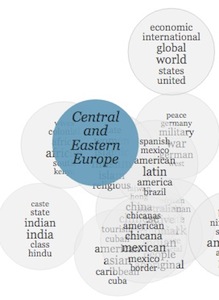
topic grouped with similar
topics in the Topic Space subview
When assessing the productivity of any scientific model, including that of digital humanities, it is important to look for the gaps it reveals and improvements for which it calls. One way the Signs model can help challenge existing scholarship on Central and Eastern Europe is by destabilizing the enduring representation of this scholarship as marginal and practice oriented, lacking critical potential and distant or removed from other areas of feminist studies. The topic model's Topic Space subview function helps to reveal existing correlations between scholarship on Eastern Europe and that on Latin America and Africa. Articles such as Ewa Majewska's "La Mestiza from Ukraine? Border Crossing with Gloria Anzaldúa" (2011), while critically engaging with questions related to the politics of naming and the politics of translation, can make a case for the relevance of the postcolonial framework to Eastern European locations and in return to Eastern European experiences of radical transformations.
In bringing together the unexpected and sometimes random combinations of elements, the topic model developed by the Signs team helps us explore the world of digital humanities, understood as scholarship that builds on and works with technology to bring us closer to multidimensional scholarly environments and practices of meaning and knowledge production. It is only a matter of further studies and researchers' creative imagination to illuminate where the quantitative and digital approaches to humanities, such as the one proposed by the Signs team, will take us in the future.
Magdalena Grabowska is Assistant Professor at the Institute for Philosophy and Sociology at the Polish Academy of Sciences.
References
Braidotti, Rosi. 2000. "Once upon a Time in Europe." Signs: Journal of Women in Culture and Society 25(4):1061-64.
Clements, Barbara Evans. 1982. "Working-Class and Peasant Women in the Russian Revolution, 1917-1923." Signs 8(2):215-35.
Funk, Nanette. 2004. "Feminist Critiques of Liberalism: Can They Travel East? Their Relevance in Eastern and Central Europe and the Former Soviet Union." Signs 29(3):695-726.
Fuszara, Małgorzata. 2000. "Feminism, the New Millennium, and Ourselves: A Polish View." Signs 25(4):1069-75.
Grabowska, Magdalena. 2012. "Bringing the Second World In: Conservative Revolution(s), Socialist Legacies, and Transnational Silences in the Trajectories of Polish Feminism." Signs 37(2):385-411.
Lindenmeyr, Adele. 1993. "Public Life, Private Virtues: Women in Russian Charity, 1762-1914." Signs 18(3):562-91.
MacKinnon, Catharine A. 1982. "Feminism, Marxism, Method, and the State: An Agenda for Theory." Signs 7(3):515-44.
Majewska, Eva. 2011. "La Mestiza from Ukraine? Border Crossing with Gloria Anzaldúa." Signs 37(1):34-41.
Rosenberg, Dorothy J. 1991."Shock Therapy: GDR Women in Transition from a Socialist Welfare State to a Social Market Economy." Signs 17(1):129-51.
Rupp, Leila J., and Verta Taylor. 1999. "Forging Feminist Identity in an International Movement: A Collective Identity Approach to Twentieth-Century Feminism." Signs 24(2):363-86.
Suchland, Jennifer. 2011. "Is Postsocialism Transnational?" Signs 36(4):837-62.
Possibilities for Hidden Gems in a Rare Feminist Archive: Topic Model Browsing on Women's Labor Migrations
Danielle Phillips
As a scholar whose work focuses on the history of domestic work and women's migrations, I am accustomed to typing key words into library and journal search engines to access articles and books about women's labor migrations. Topic model browsing enhances the research process by creating a human-technological collaborative research experience. Users do not simply dictate to the tool what they would like for it to find. This tool presents its own multilayered interpretations of research topics by constructing nonlinear road maps that guide users on intersecting and overlapping pathways to feminist scholarship about the topic under study.
Topic model browsing, a tool with several distinct search methods, navigates users through the theoretical and methodological pathways that are most meaningful and useful for their own interests. For my work, for example, although none of the seventy topics is labeled migration, I am able to "travel" across several related topic areas to collect sources about women's labor migrations. What makes this intersectional research model particularly befitting for research on migration is that it reflects the complex intellectual and physical routes that scholars have traveled and created to discover women's labor and migration stories that have been traditionally marginalized in academic study.
Topic model browsing is a useful tool for multiple purposes that include but are not limited to academic research. I will examine how topic model browsing can be used for: 1) classroom instruction about the joys of what can be discovered while doing archival research across academic disciplines; and 2) activists who are interested in working with women's labor organizations "on the ground."
Topic Model Browsing and the Wired Classroom
Wired classrooms have made it possible for professors to use multimedia and tech-savvy topic model browsing. This tool helps students to trace conversations visually across the disciplines and to understand the complex ways in which scholarship is made and theories are developed through intellectual dialogue. The topic model also allows students to trace intersecting theories and bodies of literature that academics draw upon to develop their own scholarship. This function would be of particular importance for undergraduate students who are writing senior theses and graduate students who are contemplating dissertation topics or drafting dissertation proposals.
The topic model is composed of seventy categories, yet student users whose research projects are not fully captured in the topic area descriptions would not be inhibited from using the model. For instance, if students wanted to conduct research on women's labor migrations, they could insert words such as migrant, migrants, migration, domestic, and immigrant into the word search engine. After they typed in these words, the topics labeled Domestic and Urban, Rural Economies, Asian American / Caribbean, Labor, and Globalization would appear on the screen. After users click on the Globalization topic, which groups the words world, global, states, international, united, economic, transnational, state, rights, countries, a list of articles about women's labors more broadly and women's labor migrations in particular appear on the screen, including Robyn Magalit Rodriguez's "The Labor Brokerage State and the Globalization of Filipina Care Workers" (2008) and Rhacel Salazar Parreñas's "Transgressing the Nation-State: The Partial Citizenship and 'Imagined (Global) Community' of Migrant Filipina Domestic Workers" (2001).

While authors listed under this topic might not have cited each other's work, the topic model provides professors with a preliminary analytic framework in which to help students imagine scholarly conversations that the authors themselves might not have even imagined when considering a body of literature on gender, migration, and labor. For example, Adele Jones's "A Silent But Mighty River: The Costs of Women's Economic Migration" (2001) does not directly address the specific issues that the Filipina care workers in Rodriguez's article encountered, yet Jones's analysis of interregional and international women's labor migrations provides an overarching framework in which to examine Filipina women's migrations and the labor migrations of other women who migrate from poorer to wealthier countries in search of domestic service employment. In addition, professors could teach students how bodies of literature are made through explicit scholarly dialogues. Professors could conveniently point to Jones's references to Chandra Talpade Mohanty's work in her article and ask students to read Mohanty's "'Under Western Eyes' Revisited: Feminist Solidarity through Anticapitalist Struggles" (2003), which also appears on the list of articles under the Globalization topic, to gain a deeper understanding of how Jones drew from Mohanty's scholarship to construct her own argument.
The path of discovery goes deeper! The links to the individual articles contain a list of more related topic areas and articles. After one clicks on the link to Parreñas's "Transgressing the Nation-State," for instance, intersecting bodies of literature listed under other topic headings appear on the screen, indicating that the broad topic labeled The Social is the next most relevant topic to the article. Students could click on the link to this topic to view a list of articles that are broadly related to Parreñas's article. They might find Mieke Verloo's "Intersectional and Cross-Movement Politics and Policies" (2013) helpful for contextualizing the relationship between gender and policy-making that Parreñas critiques in her article and for thinking of ways to address inequalities embedded in policies that make migrant Filipina care workers susceptible to labor exploitation.
Professors could teach students about the importance of language while conducting research by pointing to the words displayed to the left of the screen under each topic area. The Labor topic, for example, indicates that the terminology most commonly used in scholarship about women's work includes work, labor, workers, working, employment, force, jobs, economic, and market. Students could cross-reference the list of words with the years in which articles were published to gain a sense of how certain terms emerged and disappeared over time to determine whether or not they are using the most current terminology. This could help students determine which terms and concepts they would need to use in order to enter scholarly conversations about women's labors.
Professors could also point students to the graph that appears above the list of articles to help them pose questions about the larger scope of their projects. These questions might include: Who am I in this conversation with about women's labors? Who are my intellectual predecessors? How have studies about women's labor migrations changed over time? Am I extending a strand of feminist scholarship that has declined and could be revived through my dissertation or manuscript, or am I entering a conversation that is popular among scholars at the moment? The graph could also be useful for graduate students in women's studies programs who are preparing for qualifying exams. Students could cross-reference the graph with the Curated Table of Contents to map the field of women's studies and trace strands of feminist thought.
In sum, professors could make use of the word search engine, graphs, list of commonly used words, and circuitous links of scholarship and theories to teach students methodology in ways that would prepare them for writing senior theses and dissertations on any subject and in any discipline. The multipurpose features of the topic model, however, are not limited to the walls of a classroom. In the following section, I will explore how labor activists can use topic model browsing to bring scholarship to "the ground" in ways that could benefit their projects.
Taking Topic Model Browsing to the Streets
It is critical for activists to develop an understanding about the community of workers they would like to work with before waging campaigns against labor exploitation. Using the tool, activists would be able to access several articles listed under the topic model that provide significant information for their projects. For example, activists interested in working with women factory workers in Los Angeles would need to read Richard Sullivan and Kimi Lee's "Organizing Immigrant Women in America's Sweatshops: Lessons from the Los Angeles Garment Worker Center" (2008) listed under the Labor topic. It would also be necessary for activists interested in campaigning for migrant women workers in Costa Rica to read Sang E. Lee's "Unpacking the Packing Plant: Nicaraguan Migrant Women's Work in Costa Rica's Evolving Export Agriculture Sector" (2010) listed under topic 35. Activists interested in working with women entrepreneurs who received microcredit loans would find it useful to read Christine Keating, Claire Rasmussen, and Pooja Rishi's "The Rationality of Empowerment: Microcredit, Accumulation by Dispossession, and the Gendered Economy" (2010).
The immense resources on activism included in the topic model areas challenge notions that there is a divide between theory and practice. The topic model also disrupts assumptions that academic journals and articles are disconnected from what happens "on the ground." As a tool that collates literature on the activism of women migrants, the topic model could be an important resource for labor activists who are interested in working directly with women's labor organizations. Hence, the topic model blurs binary thinking of theory and practice by foregrounding sources that push users to think about the connections between scholarship and activism and scholarship as activism.
Danielle Phillips is Assistant Professor of Women's Studies at Texas Woman's University.
References
Jones, Adele. 2001. "A Silent but Mighty River: The Costs of Women's Economic Migration." Signs: Journal of Women in Culture and Society 33(4):761–69.
Keating, Christine, Claire Rasumssen, and Pooja Rishi. 2010. "The Rationality of Empowerment: Microcredit, Accumulation by Dispossession, and the Gendered Economy." Signs 36(1):153–76.
Lee, Sang E. 2010. "Unpacking the Packing Plant: Nicaraguan Migrant Women's Work in Costa Rica's Evolving Export Agriculture Sector." Signs 35(2):317–42.
Mohanty, Chandra Talpade. 2003. "'Under Western Eyes' Revisited: Feminist Solidarity through Anticapitalist Struggles." Signs 28(2):499–535.
Parreñas, Rhacel Salazar. 2001. "Transgressing the Nation-State: The Partial Citizenship and 'Imagined (Global) Community' of Migrant Filipina Domestic Workers." Signs 26(4):1129–54.
Rodriguez, Robyn Magalit. 2008. "The Labor Brokerage State and the Globalization of Filipina Care Workers." Signs 33(4):794–800.
Sullivan, Richard, and Kimi Lee. 2008. "Organizing Immigrant Women in America's Sweatshops: Lessons from the Los Angeles Garment Worker Center." Signs 33(3):527–32.
Verloo, Mieke. 2013. "Intersectional and Cross-Movement Politics and Policies: Reflections on Current Practices and Debates." Signs 38(4):893–915.
Fluidity and Labor in Signs@40
Miranda Outman
Signs' 40th anniversary website represents an extraordinary space for fluidity, motion, and play. In the interactive Cocitation Network Graph, feminist scholars' names-in vivid color-appear to skate and skitter across a frictionless surface. Pull one name across the screen, and a network of names swims with it. In the background the larger network orbits and spirals, the connections made over decades of meticulous scholarship seeming, here, to serve as a gravitational pull within a feminist scholarly outer space. Click on Years within the Topic Model Browser, and the themes and foci appear as a crazy quilt, a sea of color representing the shifts and continuities over four decades of scholarship in Signs. Toggle from Topic Grid to Topic Space, and neat rows of topic bubbles swim across the screen to overlap, revealing the myriad connections and interconnections forged over the journal's history. The site is interactive and responsive, and in its open-endedness, it invites feminist scholars—in an era of academic job searches and tenure review; teaching, research, and administrative demands—to do something dangerous and subversive: to lose time. And by making visible connections that might never be revealed through a linear reading of the journal's content, the site begins to deliver on a foundational aim of feminist scholarship: to unsettle old assumptions and reveal hidden linkages; to question the taken-for-granted and reveal the unacknowledged. To do what the journal's founding editors set out to do in their very first editorial: "to amass fresh data, and to generate new concepts, tools, and techniques ... to question the social, political, economic, cultural, and psychological arrangements that have governed relations between females and males, that have defined femininity and masculinity" (Stimpson et al. 1975, v).
And yet, this extraordinary project brings to mind another, less obvious feminist imperative: to acknowledge invisible labor. A surface, by this logic, is not just clean: it has been cleaned. A building is not just an edifice, it is a process, the act of building. Increasingly, a space that is wild and untouched remains so because it has been protected. And all of this labor-cleaning, building, protecting-is gendered, raced, and classed. Signs's 40th anniversary site owes its existence to hours, weeks, and months of labor: programming, research, design, coding, and testing. If the elements move smoothly, it is because it has been coded and recoded, with bugs and glitches meticulously removed. If it is generative of new thinking, it is because it was formulated with broad and challenging questions from the outset. The quantitative project was launched with helpful trainings in content analysis and archive construction by Signs Associate Editor Dana Britton. Signs Digital Humanities Fellow Andrew Goldstone invested invaluable labor in developing and refining the software that enables the exploration of the topic model and in identifying and resolving problems in the data set provided by JSTOR's Data for Research service. Women's Studies Librarian and Director of the Margery Somers Foster Digital Archive at Rutgers University Libraries Kayo Denda provided technical guidance and support throughout the project. Women's and Gender Studies doctoral students Susana Galán, Lindsey Whitmore, and Signs Acquisitions Manager C. Laura Lovin contributed essential research and participated in the development and implementation of the site at every stage. Signs Deputy Editor, Andrew Mazzaschi, more than anyone, is the author of this site. He is responsible for the site's design and for its implementation at every stage, via a set of highly technical, sophisticated processes-largely self-taught—requiring uncommon patience, diligence, and foresight. I say all this from my perspective as Signs Managing Editor, who witnessed the development of Signs@40, replete with setbacks and stumbling blocks, over countless hours, including many long nights, over the course or more than a year—at the same time that all the demanding tasks of journal acquisitions and production moved forward seamlessly and on schedule. The site owes its genesis to the pioneering vision of Signs Editor Mary Hawkesworth and to the support of Michael Magoulias and Jennifer Ringblom at the University of Chicago Press. As a digital framework for exploring the corpus of Signs, it owes its existence to the larger framework of the Internet and the computing processes that sustain it. Although the Internet is credited to the clandestine work of the Defense Advanced Research Projects Agency of the U.S. Department of Defense, the computing processes that undergird it have been traced to the unacknowledged labor of women (Perry and Greber 1990; Hawkesworth 2012; Kinsey 2014). And, of course, the site owes its existence to Signs, to all the of the editors who have guided it (including the incoming editor, who has taken on the challenge and the promise of the journal's next chapter); as well as the authors whose articles can be explored here; the staff, associate editors, and host universities at the seven editorial offices to date; and the directors, editors, and staff at the University of Chicago Press. And, perhaps most of all, as an interactive digital framework with limitless possibilities, this site belongs to the users and readers who will employ it as a framework for reflection and research, and the present and future subscribers, readers, and interlocutors of Signs.
Miranda Outman is Managing Editor of Signs.
References
Hawkesworth, Mary. 2012. "Virtual Politics." In her Political Worlds of Women: Activism, Advocacy, and Governance in the Twenty-First Century, 279-313. Boulder, CO: Westview.
Kinsey, Cadence. 2014."Matrices of Embodiment: Rethinking Binary and the Politics of Digital Representation." Signs: Journal of Women in Culture and Society 39(4):897-925.
Perry, Ruth, and Lisa Greber. 1990. "Women and Computers: An Introduction." Signs 16(1):74-101.
Stimpson, Catharine, Joan N. Burstyn, Domna C. Stanton, and Sandra M. Whisler. 1975. "Editorial." Signs 1(1):v-viii.
